Assessing Physical Health Status - Assessment 2 Response Template
VerifiedAdded on 2023/01/10
|17
|6403
|58
AI Summary
This response template provides a care plan for Yu Yan, addressing her nursing diagnoses and interventions. It also discusses the impact of her values and attitudes on timely discharge, her developmental stage, and physiological changes. Additionally, it explores the benefits of a wellness approach to health and suggests a community support agency. The template also covers the stages of human growth and development and the impact of genetics and environment. Lastly, it outlines the requirements for Yu Yan's discharge.
Contribute Materials
Your contribution can guide someone’s learning journey. Share your
documents today.
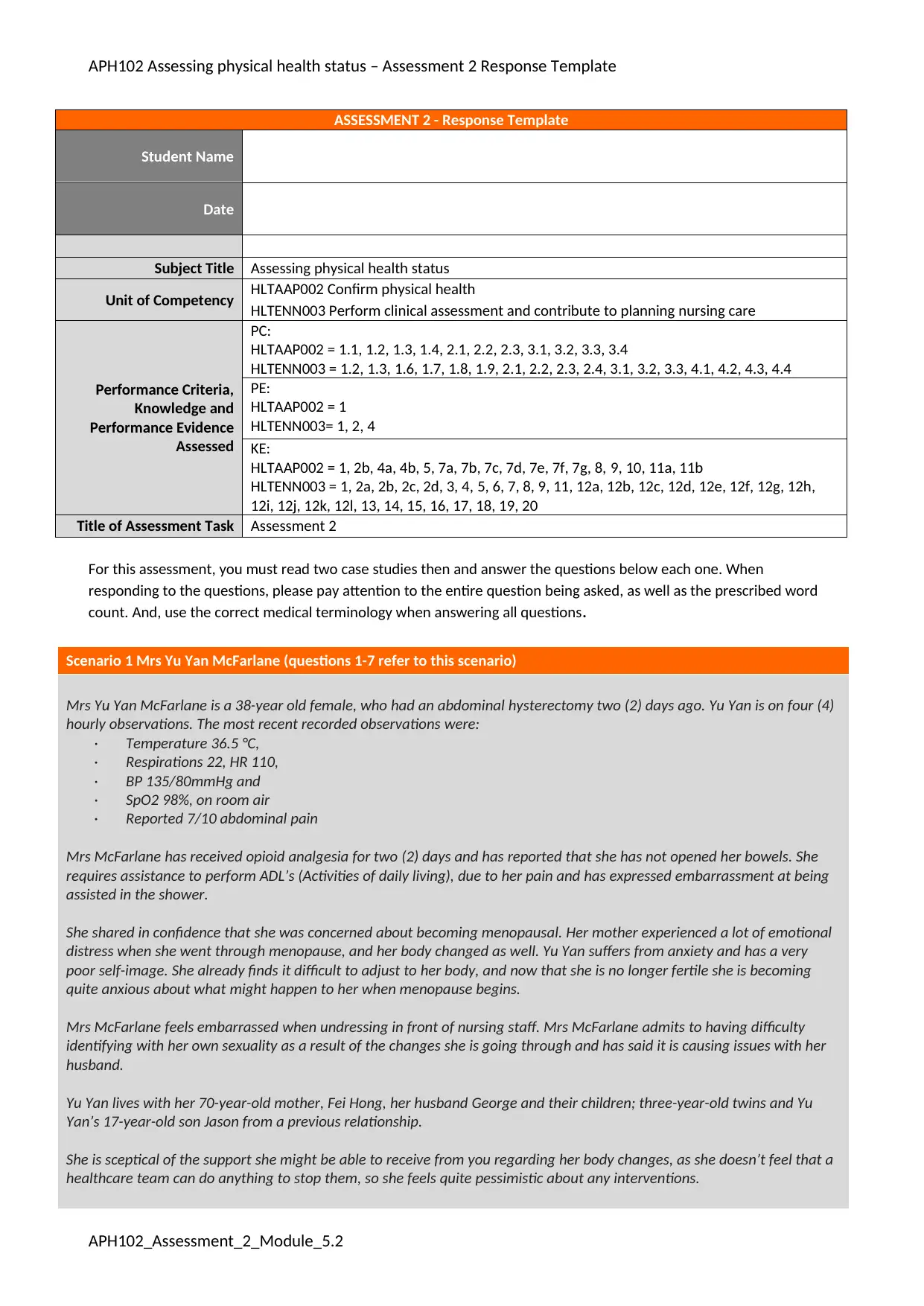
APH102 Assessing physical health status – Assessment 2 Response Template
ASSESSMENT 2 - Response Template
Student Name
Date
Subject Title Assessing physical health status
Unit of Competency HLTAAP002 Confirm physical health
HLTENN003 Perform clinical assessment and contribute to planning nursing care
Performance Criteria,
Knowledge and
Performance Evidence
Assessed
PC:
HLTAAP002 = 1.1, 1.2, 1.3, 1.4, 2.1, 2.2, 2.3, 3.1, 3.2, 3.3, 3.4
HLTENN003 = 1.2, 1.3, 1.6, 1.7, 1.8, 1.9, 2.1, 2.2, 2.3, 2.4, 3.1, 3.2, 3.3, 4.1, 4.2, 4.3, 4.4
PE:
HLTAAP002 = 1
HLTENN003= 1, 2, 4
KE:
HLTAAP002 = 1, 2b, 4a, 4b, 5, 7a, 7b, 7c, 7d, 7e, 7f, 7g, 8, 9, 10, 11a, 11b
HLTENN003 = 1, 2a, 2b, 2c, 2d, 3, 4, 5, 6, 7, 8, 9, 11, 12a, 12b, 12c, 12d, 12e, 12f, 12g, 12h,
12i, 12j, 12k, 12l, 13, 14, 15, 16, 17, 18, 19, 20
Title of Assessment Task Assessment 2
For this assessment, you must read two case studies then and answer the questions below each one. When
responding to the questions, please pay attention to the entire question being asked, as well as the prescribed word
count. And, use the correct medical terminology when answering all questions.
Scenario 1 Mrs Yu Yan McFarlane (questions 1-7 refer to this scenario)
Mrs Yu Yan McFarlane is a 38-year old female, who had an abdominal hysterectomy two (2) days ago. Yu Yan is on four (4)
hourly observations. The most recent recorded observations were:
· Temperature 36.5 °C,
· Respirations 22, HR 110,
· BP 135/80mmHg and
· SpO2 98%, on room air
· Reported 7/10 abdominal pain
Mrs McFarlane has received opioid analgesia for two (2) days and has reported that she has not opened her bowels. She
requires assistance to perform ADL’s (Activities of daily living), due to her pain and has expressed embarrassment at being
assisted in the shower.
She shared in confidence that she was concerned about becoming menopausal. Her mother experienced a lot of emotional
distress when she went through menopause, and her body changed as well. Yu Yan suffers from anxiety and has a very
poor self-image. She already finds it difficult to adjust to her body, and now that she is no longer fertile she is becoming
quite anxious about what might happen to her when menopause begins.
Mrs McFarlane feels embarrassed when undressing in front of nursing staff. Mrs McFarlane admits to having difficulty
identifying with her own sexuality as a result of the changes she is going through and has said it is causing issues with her
husband.
Yu Yan lives with her 70-year-old mother, Fei Hong, her husband George and their children; three-year-old twins and Yu
Yan’s 17-year-old son Jason from a previous relationship.
She is sceptical of the support she might be able to receive from you regarding her body changes, as she doesn’t feel that a
healthcare team can do anything to stop them, so she feels quite pessimistic about any interventions.
APH102_Assessment_2_Module_5.2
ASSESSMENT 2 - Response Template
Student Name
Date
Subject Title Assessing physical health status
Unit of Competency HLTAAP002 Confirm physical health
HLTENN003 Perform clinical assessment and contribute to planning nursing care
Performance Criteria,
Knowledge and
Performance Evidence
Assessed
PC:
HLTAAP002 = 1.1, 1.2, 1.3, 1.4, 2.1, 2.2, 2.3, 3.1, 3.2, 3.3, 3.4
HLTENN003 = 1.2, 1.3, 1.6, 1.7, 1.8, 1.9, 2.1, 2.2, 2.3, 2.4, 3.1, 3.2, 3.3, 4.1, 4.2, 4.3, 4.4
PE:
HLTAAP002 = 1
HLTENN003= 1, 2, 4
KE:
HLTAAP002 = 1, 2b, 4a, 4b, 5, 7a, 7b, 7c, 7d, 7e, 7f, 7g, 8, 9, 10, 11a, 11b
HLTENN003 = 1, 2a, 2b, 2c, 2d, 3, 4, 5, 6, 7, 8, 9, 11, 12a, 12b, 12c, 12d, 12e, 12f, 12g, 12h,
12i, 12j, 12k, 12l, 13, 14, 15, 16, 17, 18, 19, 20
Title of Assessment Task Assessment 2
For this assessment, you must read two case studies then and answer the questions below each one. When
responding to the questions, please pay attention to the entire question being asked, as well as the prescribed word
count. And, use the correct medical terminology when answering all questions.
Scenario 1 Mrs Yu Yan McFarlane (questions 1-7 refer to this scenario)
Mrs Yu Yan McFarlane is a 38-year old female, who had an abdominal hysterectomy two (2) days ago. Yu Yan is on four (4)
hourly observations. The most recent recorded observations were:
· Temperature 36.5 °C,
· Respirations 22, HR 110,
· BP 135/80mmHg and
· SpO2 98%, on room air
· Reported 7/10 abdominal pain
Mrs McFarlane has received opioid analgesia for two (2) days and has reported that she has not opened her bowels. She
requires assistance to perform ADL’s (Activities of daily living), due to her pain and has expressed embarrassment at being
assisted in the shower.
She shared in confidence that she was concerned about becoming menopausal. Her mother experienced a lot of emotional
distress when she went through menopause, and her body changed as well. Yu Yan suffers from anxiety and has a very
poor self-image. She already finds it difficult to adjust to her body, and now that she is no longer fertile she is becoming
quite anxious about what might happen to her when menopause begins.
Mrs McFarlane feels embarrassed when undressing in front of nursing staff. Mrs McFarlane admits to having difficulty
identifying with her own sexuality as a result of the changes she is going through and has said it is causing issues with her
husband.
Yu Yan lives with her 70-year-old mother, Fei Hong, her husband George and their children; three-year-old twins and Yu
Yan’s 17-year-old son Jason from a previous relationship.
She is sceptical of the support she might be able to receive from you regarding her body changes, as she doesn’t feel that a
healthcare team can do anything to stop them, so she feels quite pessimistic about any interventions.
APH102_Assessment_2_Module_5.2
Secure Best Marks with AI Grader
Need help grading? Try our AI Grader for instant feedback on your assignments.
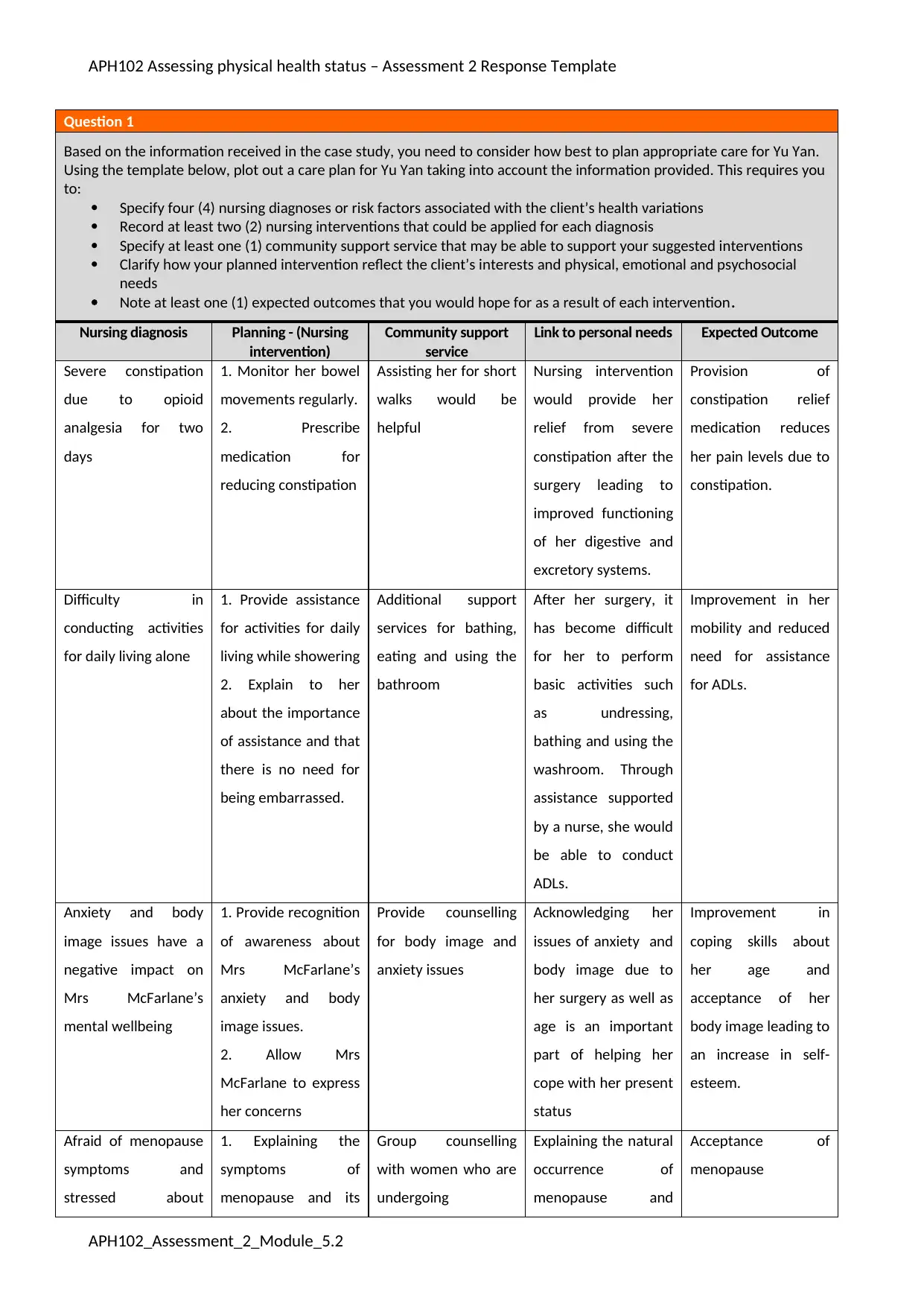
APH102 Assessing physical health status – Assessment 2 Response Template
Question 1
Based on the information received in the case study, you need to consider how best to plan appropriate care for Yu Yan.
Using the template below, plot out a care plan for Yu Yan taking into account the information provided. This requires you
to:
Specify four (4) nursing diagnoses or risk factors associated with the client’s health variations
Record at least two (2) nursing interventions that could be applied for each diagnosis
Specify at least one (1) community support service that may be able to support your suggested interventions
Clarify how your planned intervention reflect the client’s interests and physical, emotional and psychosocial
needs
Note at least one (1) expected outcomes that you would hope for as a result of each intervention.
Nursing diagnosis Planning - (Nursing
intervention)
Community support
service
Link to personal needs Expected Outcome
Severe constipation
due to opioid
analgesia for two
days
1. Monitor her bowel
movements regularly.
2. Prescribe
medication for
reducing constipation
Assisting her for short
walks would be
helpful
Nursing intervention
would provide her
relief from severe
constipation after the
surgery leading to
improved functioning
of her digestive and
excretory systems.
Provision of
constipation relief
medication reduces
her pain levels due to
constipation.
Difficulty in
conducting activities
for daily living alone
1. Provide assistance
for activities for daily
living while showering
2. Explain to her
about the importance
of assistance and that
there is no need for
being embarrassed.
Additional support
services for bathing,
eating and using the
bathroom
After her surgery, it
has become difficult
for her to perform
basic activities such
as undressing,
bathing and using the
washroom. Through
assistance supported
by a nurse, she would
be able to conduct
ADLs.
Improvement in her
mobility and reduced
need for assistance
for ADLs.
Anxiety and body
image issues have a
negative impact on
Mrs McFarlane’s
mental wellbeing
1. Provide recognition
of awareness about
Mrs McFarlane’s
anxiety and body
image issues.
2. Allow Mrs
McFarlane to express
her concerns
Provide counselling
for body image and
anxiety issues
Acknowledging her
issues of anxiety and
body image due to
her surgery as well as
age is an important
part of helping her
cope with her present
status
Improvement in
coping skills about
her age and
acceptance of her
body image leading to
an increase in self-
esteem.
Afraid of menopause
symptoms and
stressed about
1. Explaining the
symptoms of
menopause and its
Group counselling
with women who are
undergoing
Explaining the natural
occurrence of
menopause and
Acceptance of
menopause
APH102_Assessment_2_Module_5.2
Question 1
Based on the information received in the case study, you need to consider how best to plan appropriate care for Yu Yan.
Using the template below, plot out a care plan for Yu Yan taking into account the information provided. This requires you
to:
Specify four (4) nursing diagnoses or risk factors associated with the client’s health variations
Record at least two (2) nursing interventions that could be applied for each diagnosis
Specify at least one (1) community support service that may be able to support your suggested interventions
Clarify how your planned intervention reflect the client’s interests and physical, emotional and psychosocial
needs
Note at least one (1) expected outcomes that you would hope for as a result of each intervention.
Nursing diagnosis Planning - (Nursing
intervention)
Community support
service
Link to personal needs Expected Outcome
Severe constipation
due to opioid
analgesia for two
days
1. Monitor her bowel
movements regularly.
2. Prescribe
medication for
reducing constipation
Assisting her for short
walks would be
helpful
Nursing intervention
would provide her
relief from severe
constipation after the
surgery leading to
improved functioning
of her digestive and
excretory systems.
Provision of
constipation relief
medication reduces
her pain levels due to
constipation.
Difficulty in
conducting activities
for daily living alone
1. Provide assistance
for activities for daily
living while showering
2. Explain to her
about the importance
of assistance and that
there is no need for
being embarrassed.
Additional support
services for bathing,
eating and using the
bathroom
After her surgery, it
has become difficult
for her to perform
basic activities such
as undressing,
bathing and using the
washroom. Through
assistance supported
by a nurse, she would
be able to conduct
ADLs.
Improvement in her
mobility and reduced
need for assistance
for ADLs.
Anxiety and body
image issues have a
negative impact on
Mrs McFarlane’s
mental wellbeing
1. Provide recognition
of awareness about
Mrs McFarlane’s
anxiety and body
image issues.
2. Allow Mrs
McFarlane to express
her concerns
Provide counselling
for body image and
anxiety issues
Acknowledging her
issues of anxiety and
body image due to
her surgery as well as
age is an important
part of helping her
cope with her present
status
Improvement in
coping skills about
her age and
acceptance of her
body image leading to
an increase in self-
esteem.
Afraid of menopause
symptoms and
stressed about
1. Explaining the
symptoms of
menopause and its
Group counselling
with women who are
undergoing
Explaining the natural
occurrence of
menopause and
Acceptance of
menopause
APH102_Assessment_2_Module_5.2
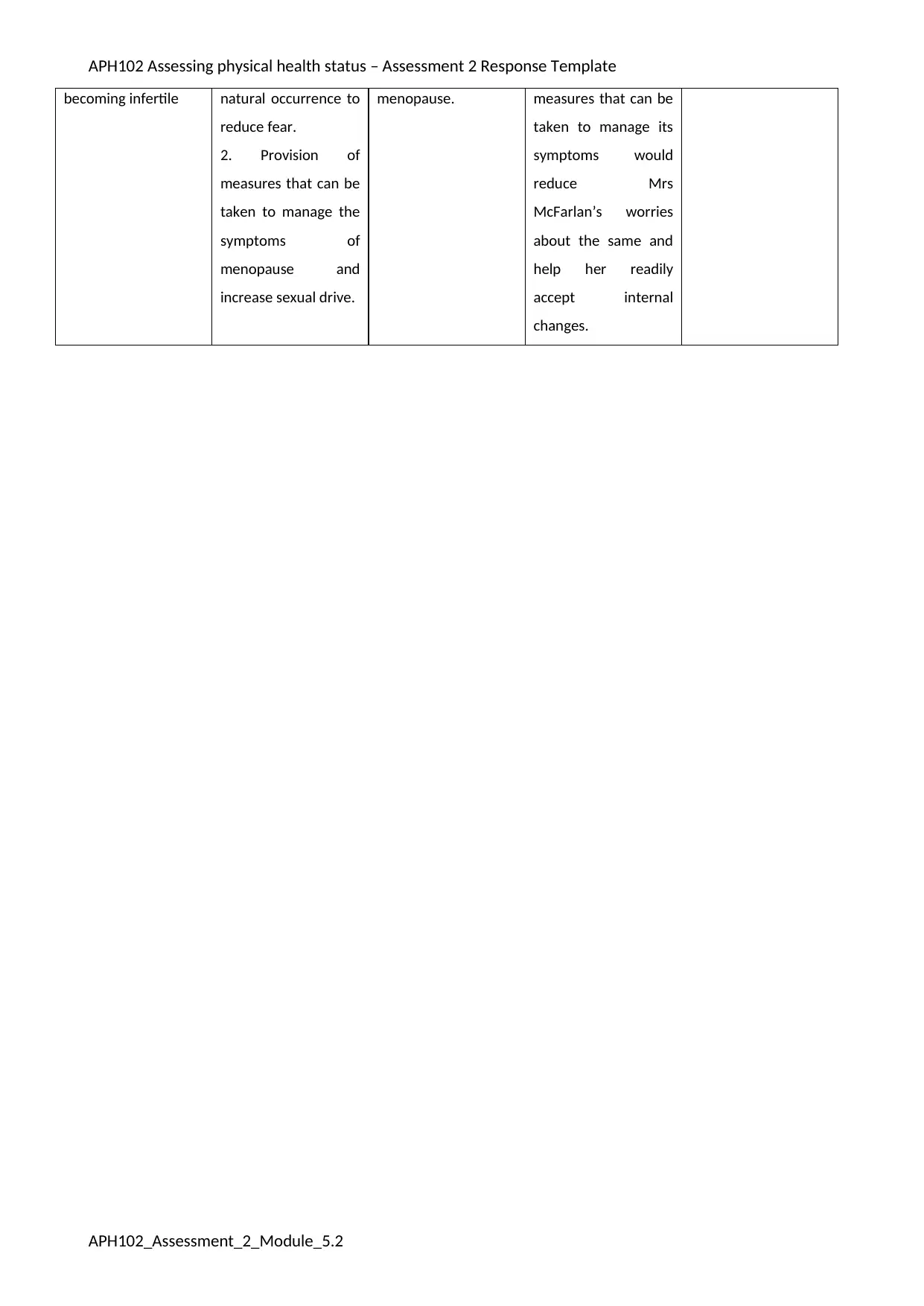
APH102 Assessing physical health status – Assessment 2 Response Template
becoming infertile natural occurrence to
reduce fear.
2. Provision of
measures that can be
taken to manage the
symptoms of
menopause and
increase sexual drive.
menopause. measures that can be
taken to manage its
symptoms would
reduce Mrs
McFarlan’s worries
about the same and
help her readily
accept internal
changes.
APH102_Assessment_2_Module_5.2
becoming infertile natural occurrence to
reduce fear.
2. Provision of
measures that can be
taken to manage the
symptoms of
menopause and
increase sexual drive.
menopause. measures that can be
taken to manage its
symptoms would
reduce Mrs
McFarlan’s worries
about the same and
help her readily
accept internal
changes.
APH102_Assessment_2_Module_5.2

APH102 Assessing physical health status – Assessment 2 Response Template
Question 2
Mrs. McFarlane has confided that she has had trouble adjusting to her body image now that she is no longer fertile.
In 20 words, suggest how Yu Yan’s values and attitudes regarding health care, and the issues/anxieties she has
may impact on a timely discharge.
Specify what developmental stage of adulthood Yu Yan is going through, and list two (2) additional Physiological
changes people go through at that stage.
Also, list two (2) other stages of adulthood and for each, specify two (2) psychosocial or psychological changes
that might be experienced by people going through them.
Response:
Yu Yan’s values and attitudes associated with healthcare care and anxiety issues have a direct impact on her timely
discharge. Her lack of trust in the healthcare system is evident from increased embarrassment while receiving assistance
for ADLs. As per the views of Davis-Floyd (2018), abdominal hysterectomy requires monitoring of the patient’s physical
along with mental needs. This is because the surgery leads to infertility causing further body image issues. Monitoring of
mental stability and acceptance is crucial in the time discharge of Mrs McFarlan. As per the stages of adulthood, it is
evident that the developmental stage Yu Yan is at is “middle adulthood”. At this stage, an individual undergoes rapid
bodily changes later on. People aged between 31-50 years below to this stage. 2 physiological changes people go through
at that stage are reduction in physical ability and an increase in skin sagging and wrinkles among women. The two other
stages of adulthood include early and late adulthood. Psychosocial changes witnessed in early adulthood are a need for
acceptance and intimacy as well as the need to start a strong relationship. On the other hand, psychosocial changes
experienced by people at late adulthood include the feelings of stagnation of growth and need to create a legacy for
themselves.
Question 3
Mrs. McFarlane has expressed embarrassment at needing assistance with her ADL’s (Activities of daily living) due to her
poor self-image. This implies she may need support emotionally as well as physically. In 50 words, explain:
What a wellness approach to health is
How it may benefit Yu Yan given her current anxieties
How you would clarify with Yu Yan that this approach would align with her needs
And, provide one (1) community support agency that may be able to assist you to when facilitating a wellness
approach to care
Response:
A wellness approach to health focuses on holistic care towards improving both physical and mental health. According to
Mullis et al. (2016), a wellness approach to health involves being aware of the need for making healthy lifestyle choices in
order to lead a healthy life. Incorporation of a wellness approach would significantly help Yu Yan to accept her present
condition and to deal with her anxiety. By becoming aware of her bodily changes and that she needs to take care of herself
through exercise and a healthy diet would lead her to accept her age and bodily changes. Clarification of incorporating a
wellness approach to health would be provided to Yu Yan by explaining to her that she would be able to manage her
emotions and physical changes due to menopause efficiently. It would further be suggested to her that she would be able
to manage her body image issues and sexuality in a better manner through this approach. The Home and Community Care
agency is one such wellness approach to care agency which provides its services for individuals requiring the same
(health.vic.gov.au, 2020). Partnering up with the agency would enable the nurse to develop a holistic care plan for meeting
Yu Yan’s needs.
APH102_Assessment_2_Module_5.2
Question 2
Mrs. McFarlane has confided that she has had trouble adjusting to her body image now that she is no longer fertile.
In 20 words, suggest how Yu Yan’s values and attitudes regarding health care, and the issues/anxieties she has
may impact on a timely discharge.
Specify what developmental stage of adulthood Yu Yan is going through, and list two (2) additional Physiological
changes people go through at that stage.
Also, list two (2) other stages of adulthood and for each, specify two (2) psychosocial or psychological changes
that might be experienced by people going through them.
Response:
Yu Yan’s values and attitudes associated with healthcare care and anxiety issues have a direct impact on her timely
discharge. Her lack of trust in the healthcare system is evident from increased embarrassment while receiving assistance
for ADLs. As per the views of Davis-Floyd (2018), abdominal hysterectomy requires monitoring of the patient’s physical
along with mental needs. This is because the surgery leads to infertility causing further body image issues. Monitoring of
mental stability and acceptance is crucial in the time discharge of Mrs McFarlan. As per the stages of adulthood, it is
evident that the developmental stage Yu Yan is at is “middle adulthood”. At this stage, an individual undergoes rapid
bodily changes later on. People aged between 31-50 years below to this stage. 2 physiological changes people go through
at that stage are reduction in physical ability and an increase in skin sagging and wrinkles among women. The two other
stages of adulthood include early and late adulthood. Psychosocial changes witnessed in early adulthood are a need for
acceptance and intimacy as well as the need to start a strong relationship. On the other hand, psychosocial changes
experienced by people at late adulthood include the feelings of stagnation of growth and need to create a legacy for
themselves.
Question 3
Mrs. McFarlane has expressed embarrassment at needing assistance with her ADL’s (Activities of daily living) due to her
poor self-image. This implies she may need support emotionally as well as physically. In 50 words, explain:
What a wellness approach to health is
How it may benefit Yu Yan given her current anxieties
How you would clarify with Yu Yan that this approach would align with her needs
And, provide one (1) community support agency that may be able to assist you to when facilitating a wellness
approach to care
Response:
A wellness approach to health focuses on holistic care towards improving both physical and mental health. According to
Mullis et al. (2016), a wellness approach to health involves being aware of the need for making healthy lifestyle choices in
order to lead a healthy life. Incorporation of a wellness approach would significantly help Yu Yan to accept her present
condition and to deal with her anxiety. By becoming aware of her bodily changes and that she needs to take care of herself
through exercise and a healthy diet would lead her to accept her age and bodily changes. Clarification of incorporating a
wellness approach to health would be provided to Yu Yan by explaining to her that she would be able to manage her
emotions and physical changes due to menopause efficiently. It would further be suggested to her that she would be able
to manage her body image issues and sexuality in a better manner through this approach. The Home and Community Care
agency is one such wellness approach to care agency which provides its services for individuals requiring the same
(health.vic.gov.au, 2020). Partnering up with the agency would enable the nurse to develop a holistic care plan for meeting
Yu Yan’s needs.
APH102_Assessment_2_Module_5.2
Secure Best Marks with AI Grader
Need help grading? Try our AI Grader for instant feedback on your assignments.
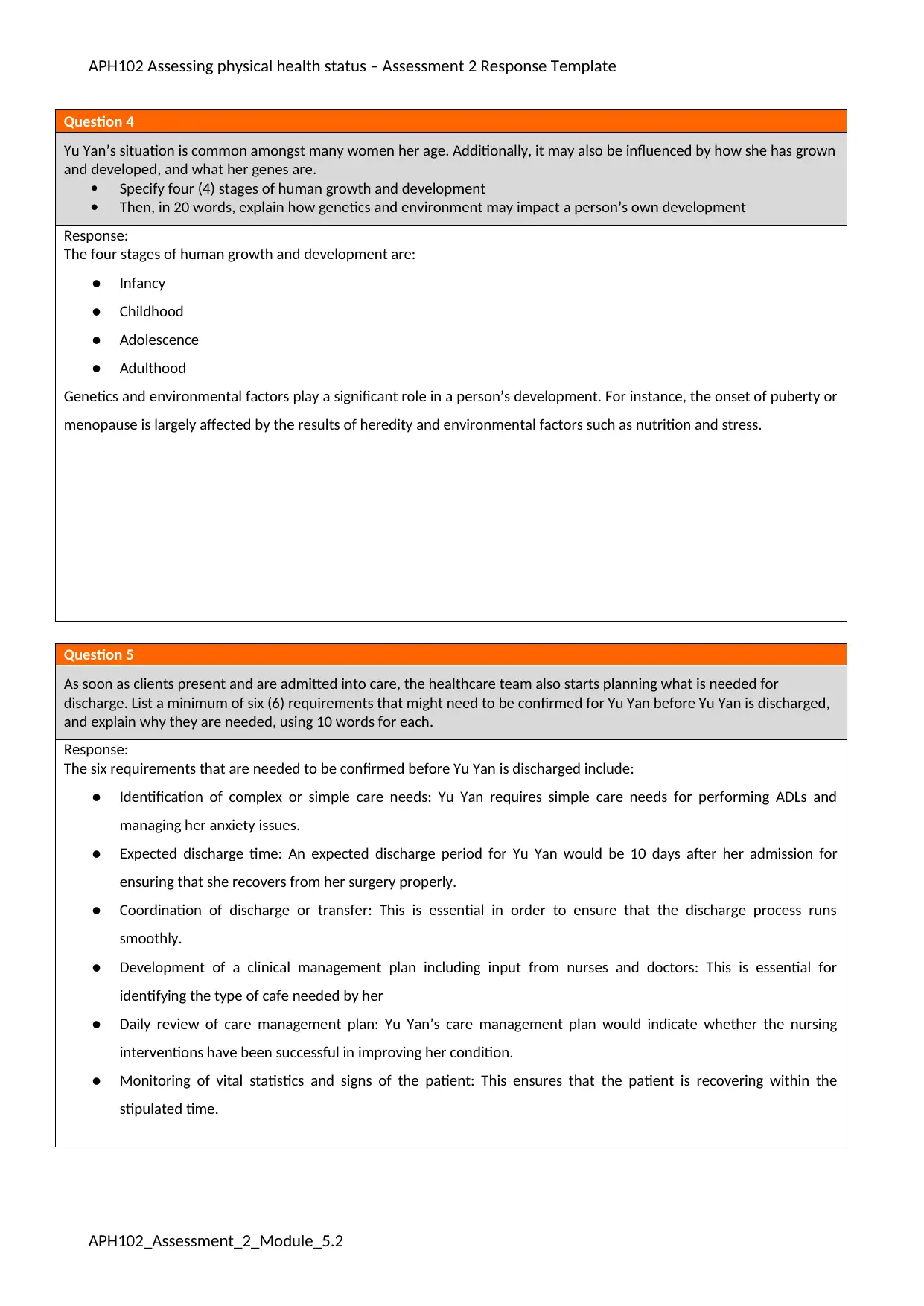
APH102 Assessing physical health status – Assessment 2 Response Template
Question 4
Yu Yan’s situation is common amongst many women her age. Additionally, it may also be influenced by how she has grown
and developed, and what her genes are.
Specify four (4) stages of human growth and development
Then, in 20 words, explain how genetics and environment may impact a person’s own development
Response:
The four stages of human growth and development are:
● Infancy
● Childhood
● Adolescence
● Adulthood
Genetics and environmental factors play a significant role in a person’s development. For instance, the onset of puberty or
menopause is largely affected by the results of heredity and environmental factors such as nutrition and stress.
Question 5
As soon as clients present and are admitted into care, the healthcare team also starts planning what is needed for
discharge. List a minimum of six (6) requirements that might need to be confirmed for Yu Yan before Yu Yan is discharged,
and explain why they are needed, using 10 words for each.
Response:
The six requirements that are needed to be confirmed before Yu Yan is discharged include:
● Identification of complex or simple care needs: Yu Yan requires simple care needs for performing ADLs and
managing her anxiety issues.
● Expected discharge time: An expected discharge period for Yu Yan would be 10 days after her admission for
ensuring that she recovers from her surgery properly.
● Coordination of discharge or transfer: This is essential in order to ensure that the discharge process runs
smoothly.
● Development of a clinical management plan including input from nurses and doctors: This is essential for
identifying the type of cafe needed by her
● Daily review of care management plan: Yu Yan’s care management plan would indicate whether the nursing
interventions have been successful in improving her condition.
● Monitoring of vital statistics and signs of the patient: This ensures that the patient is recovering within the
stipulated time.
APH102_Assessment_2_Module_5.2
Question 4
Yu Yan’s situation is common amongst many women her age. Additionally, it may also be influenced by how she has grown
and developed, and what her genes are.
Specify four (4) stages of human growth and development
Then, in 20 words, explain how genetics and environment may impact a person’s own development
Response:
The four stages of human growth and development are:
● Infancy
● Childhood
● Adolescence
● Adulthood
Genetics and environmental factors play a significant role in a person’s development. For instance, the onset of puberty or
menopause is largely affected by the results of heredity and environmental factors such as nutrition and stress.
Question 5
As soon as clients present and are admitted into care, the healthcare team also starts planning what is needed for
discharge. List a minimum of six (6) requirements that might need to be confirmed for Yu Yan before Yu Yan is discharged,
and explain why they are needed, using 10 words for each.
Response:
The six requirements that are needed to be confirmed before Yu Yan is discharged include:
● Identification of complex or simple care needs: Yu Yan requires simple care needs for performing ADLs and
managing her anxiety issues.
● Expected discharge time: An expected discharge period for Yu Yan would be 10 days after her admission for
ensuring that she recovers from her surgery properly.
● Coordination of discharge or transfer: This is essential in order to ensure that the discharge process runs
smoothly.
● Development of a clinical management plan including input from nurses and doctors: This is essential for
identifying the type of cafe needed by her
● Daily review of care management plan: Yu Yan’s care management plan would indicate whether the nursing
interventions have been successful in improving her condition.
● Monitoring of vital statistics and signs of the patient: This ensures that the patient is recovering within the
stipulated time.
APH102_Assessment_2_Module_5.2
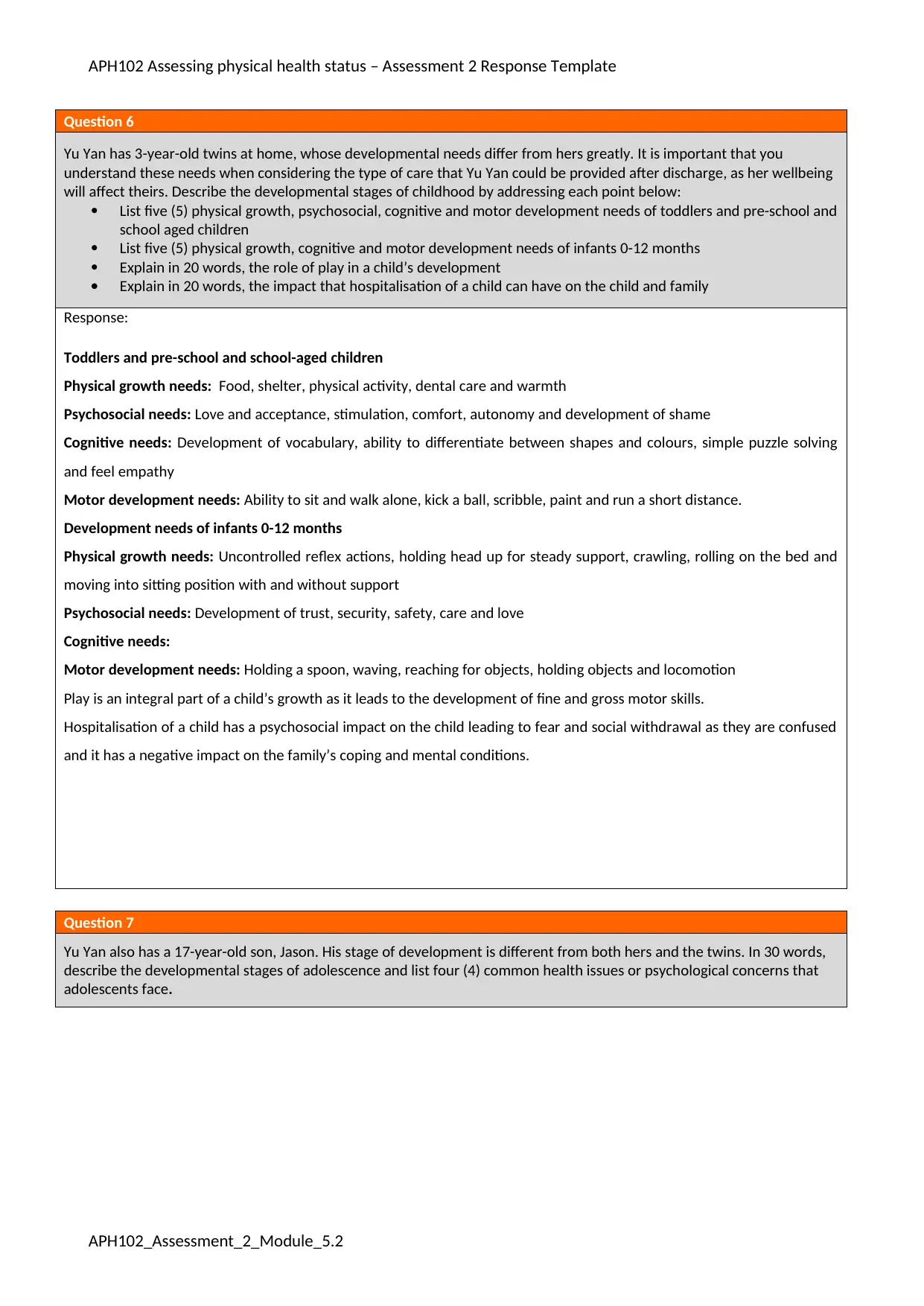
APH102 Assessing physical health status – Assessment 2 Response Template
Question 6
Yu Yan has 3-year-old twins at home, whose developmental needs differ from hers greatly. It is important that you
understand these needs when considering the type of care that Yu Yan could be provided after discharge, as her wellbeing
will affect theirs. Describe the developmental stages of childhood by addressing each point below:
List five (5) physical growth, psychosocial, cognitive and motor development needs of toddlers and pre-school and
school aged children
List five (5) physical growth, cognitive and motor development needs of infants 0-12 months
Explain in 20 words, the role of play in a child’s development
Explain in 20 words, the impact that hospitalisation of a child can have on the child and family
Response:
Toddlers and pre-school and school-aged children
Physical growth needs: Food, shelter, physical activity, dental care and warmth
Psychosocial needs: Love and acceptance, stimulation, comfort, autonomy and development of shame
Cognitive needs: Development of vocabulary, ability to differentiate between shapes and colours, simple puzzle solving
and feel empathy
Motor development needs: Ability to sit and walk alone, kick a ball, scribble, paint and run a short distance.
Development needs of infants 0-12 months
Physical growth needs: Uncontrolled reflex actions, holding head up for steady support, crawling, rolling on the bed and
moving into sitting position with and without support
Psychosocial needs: Development of trust, security, safety, care and love
Cognitive needs:
Motor development needs: Holding a spoon, waving, reaching for objects, holding objects and locomotion
Play is an integral part of a child’s growth as it leads to the development of fine and gross motor skills.
Hospitalisation of a child has a psychosocial impact on the child leading to fear and social withdrawal as they are confused
and it has a negative impact on the family’s coping and mental conditions.
Question 7
Yu Yan also has a 17-year-old son, Jason. His stage of development is different from both hers and the twins. In 30 words,
describe the developmental stages of adolescence and list four (4) common health issues or psychological concerns that
adolescents face.
APH102_Assessment_2_Module_5.2
Question 6
Yu Yan has 3-year-old twins at home, whose developmental needs differ from hers greatly. It is important that you
understand these needs when considering the type of care that Yu Yan could be provided after discharge, as her wellbeing
will affect theirs. Describe the developmental stages of childhood by addressing each point below:
List five (5) physical growth, psychosocial, cognitive and motor development needs of toddlers and pre-school and
school aged children
List five (5) physical growth, cognitive and motor development needs of infants 0-12 months
Explain in 20 words, the role of play in a child’s development
Explain in 20 words, the impact that hospitalisation of a child can have on the child and family
Response:
Toddlers and pre-school and school-aged children
Physical growth needs: Food, shelter, physical activity, dental care and warmth
Psychosocial needs: Love and acceptance, stimulation, comfort, autonomy and development of shame
Cognitive needs: Development of vocabulary, ability to differentiate between shapes and colours, simple puzzle solving
and feel empathy
Motor development needs: Ability to sit and walk alone, kick a ball, scribble, paint and run a short distance.
Development needs of infants 0-12 months
Physical growth needs: Uncontrolled reflex actions, holding head up for steady support, crawling, rolling on the bed and
moving into sitting position with and without support
Psychosocial needs: Development of trust, security, safety, care and love
Cognitive needs:
Motor development needs: Holding a spoon, waving, reaching for objects, holding objects and locomotion
Play is an integral part of a child’s growth as it leads to the development of fine and gross motor skills.
Hospitalisation of a child has a psychosocial impact on the child leading to fear and social withdrawal as they are confused
and it has a negative impact on the family’s coping and mental conditions.
Question 7
Yu Yan also has a 17-year-old son, Jason. His stage of development is different from both hers and the twins. In 30 words,
describe the developmental stages of adolescence and list four (4) common health issues or psychological concerns that
adolescents face.
APH102_Assessment_2_Module_5.2
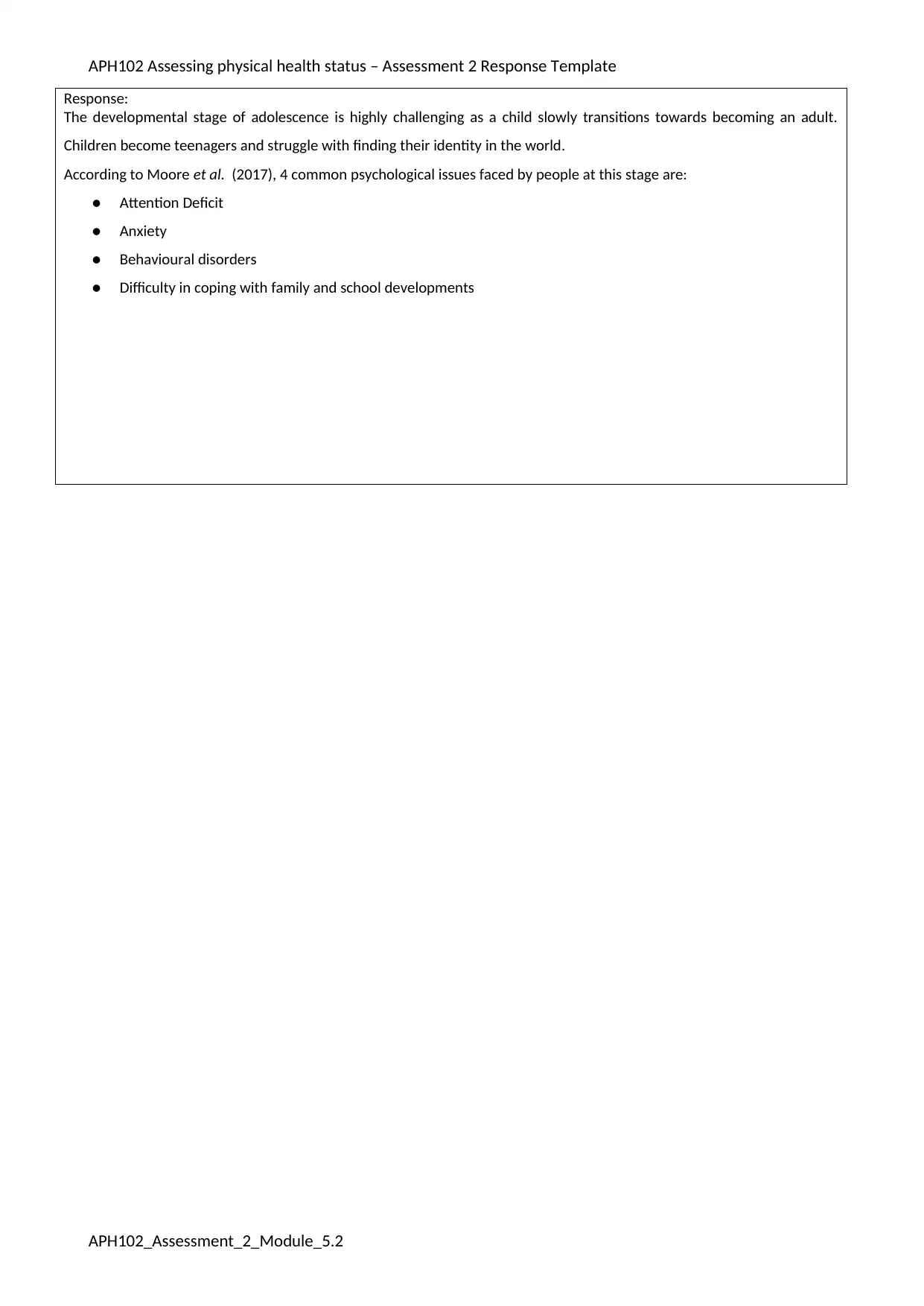
APH102 Assessing physical health status – Assessment 2 Response Template
Response:
The developmental stage of adolescence is highly challenging as a child slowly transitions towards becoming an adult.
Children become teenagers and struggle with finding their identity in the world.
According to Moore et al. (2017), 4 common psychological issues faced by people at this stage are:
● Attention Deficit
● Anxiety
● Behavioural disorders
● Difficulty in coping with family and school developments
APH102_Assessment_2_Module_5.2
Response:
The developmental stage of adolescence is highly challenging as a child slowly transitions towards becoming an adult.
Children become teenagers and struggle with finding their identity in the world.
According to Moore et al. (2017), 4 common psychological issues faced by people at this stage are:
● Attention Deficit
● Anxiety
● Behavioural disorders
● Difficulty in coping with family and school developments
APH102_Assessment_2_Module_5.2
Paraphrase This Document
Need a fresh take? Get an instant paraphrase of this document with our AI Paraphraser
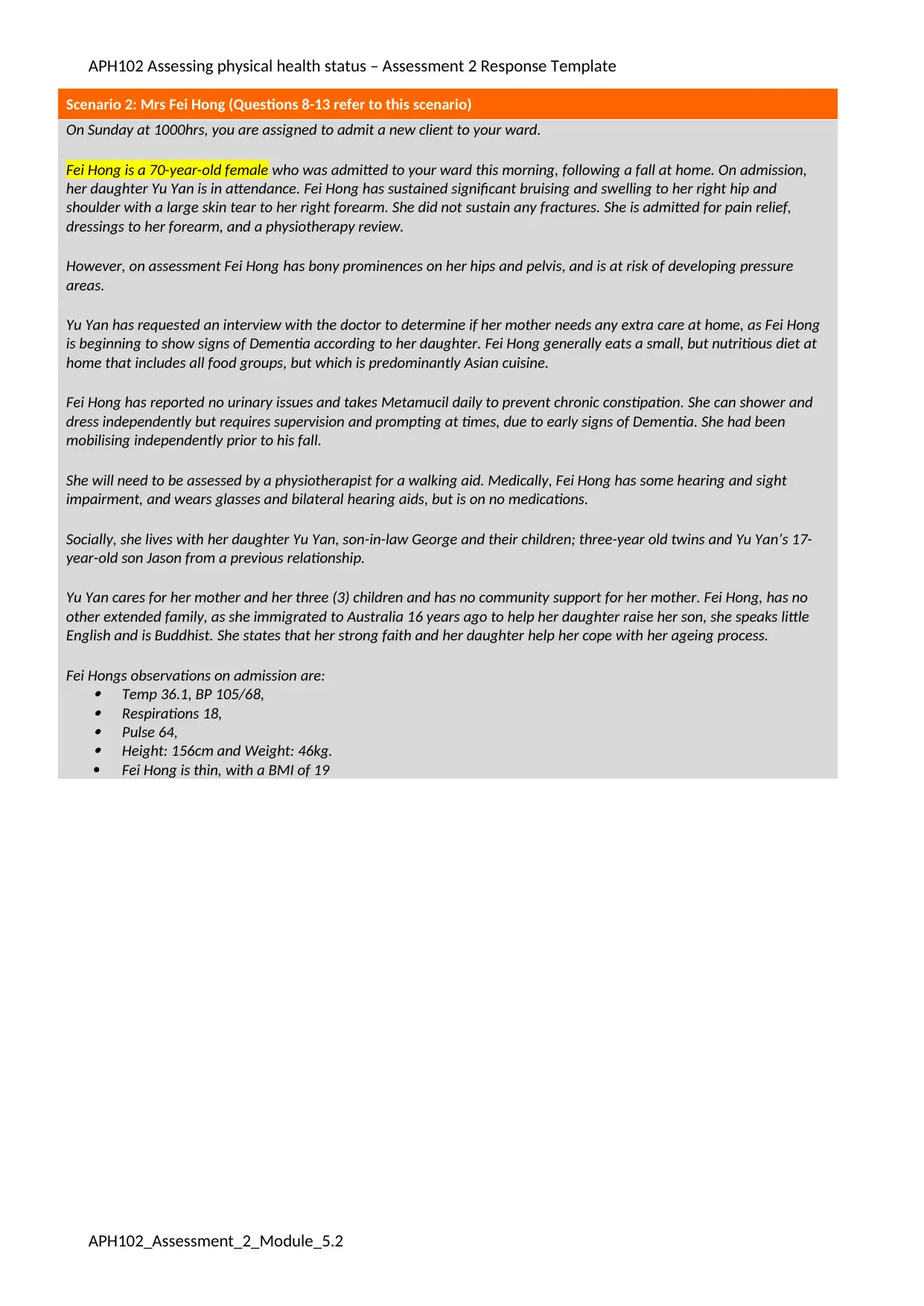
APH102 Assessing physical health status – Assessment 2 Response Template
Scenario 2: Mrs Fei Hong (Questions 8-13 refer to this scenario)
On Sunday at 1000hrs, you are assigned to admit a new client to your ward.
Fei Hong is a 70-year-old female who was admitted to your ward this morning, following a fall at home. On admission,
her daughter Yu Yan is in attendance. Fei Hong has sustained significant bruising and swelling to her right hip and
shoulder with a large skin tear to her right forearm. She did not sustain any fractures. She is admitted for pain relief,
dressings to her forearm, and a physiotherapy review.
However, on assessment Fei Hong has bony prominences on her hips and pelvis, and is at risk of developing pressure
areas.
Yu Yan has requested an interview with the doctor to determine if her mother needs any extra care at home, as Fei Hong
is beginning to show signs of Dementia according to her daughter. Fei Hong generally eats a small, but nutritious diet at
home that includes all food groups, but which is predominantly Asian cuisine.
Fei Hong has reported no urinary issues and takes Metamucil daily to prevent chronic constipation. She can shower and
dress independently but requires supervision and prompting at times, due to early signs of Dementia. She had been
mobilising independently prior to his fall.
She will need to be assessed by a physiotherapist for a walking aid. Medically, Fei Hong has some hearing and sight
impairment, and wears glasses and bilateral hearing aids, but is on no medications.
Socially, she lives with her daughter Yu Yan, son-in-law George and their children; three-year old twins and Yu Yan’s 17-
year-old son Jason from a previous relationship.
Yu Yan cares for her mother and her three (3) children and has no community support for her mother. Fei Hong, has no
other extended family, as she immigrated to Australia 16 years ago to help her daughter raise her son, she speaks little
English and is Buddhist. She states that her strong faith and her daughter help her cope with her ageing process.
Fei Hongs observations on admission are: Temp 36.1, BP 105/68, Respirations 18, Pulse 64, Height: 156cm and Weight: 46kg.
Fei Hong is thin, with a BMI of 19
APH102_Assessment_2_Module_5.2
Scenario 2: Mrs Fei Hong (Questions 8-13 refer to this scenario)
On Sunday at 1000hrs, you are assigned to admit a new client to your ward.
Fei Hong is a 70-year-old female who was admitted to your ward this morning, following a fall at home. On admission,
her daughter Yu Yan is in attendance. Fei Hong has sustained significant bruising and swelling to her right hip and
shoulder with a large skin tear to her right forearm. She did not sustain any fractures. She is admitted for pain relief,
dressings to her forearm, and a physiotherapy review.
However, on assessment Fei Hong has bony prominences on her hips and pelvis, and is at risk of developing pressure
areas.
Yu Yan has requested an interview with the doctor to determine if her mother needs any extra care at home, as Fei Hong
is beginning to show signs of Dementia according to her daughter. Fei Hong generally eats a small, but nutritious diet at
home that includes all food groups, but which is predominantly Asian cuisine.
Fei Hong has reported no urinary issues and takes Metamucil daily to prevent chronic constipation. She can shower and
dress independently but requires supervision and prompting at times, due to early signs of Dementia. She had been
mobilising independently prior to his fall.
She will need to be assessed by a physiotherapist for a walking aid. Medically, Fei Hong has some hearing and sight
impairment, and wears glasses and bilateral hearing aids, but is on no medications.
Socially, she lives with her daughter Yu Yan, son-in-law George and their children; three-year old twins and Yu Yan’s 17-
year-old son Jason from a previous relationship.
Yu Yan cares for her mother and her three (3) children and has no community support for her mother. Fei Hong, has no
other extended family, as she immigrated to Australia 16 years ago to help her daughter raise her son, she speaks little
English and is Buddhist. She states that her strong faith and her daughter help her cope with her ageing process.
Fei Hongs observations on admission are: Temp 36.1, BP 105/68, Respirations 18, Pulse 64, Height: 156cm and Weight: 46kg.
Fei Hong is thin, with a BMI of 19
APH102_Assessment_2_Module_5.2
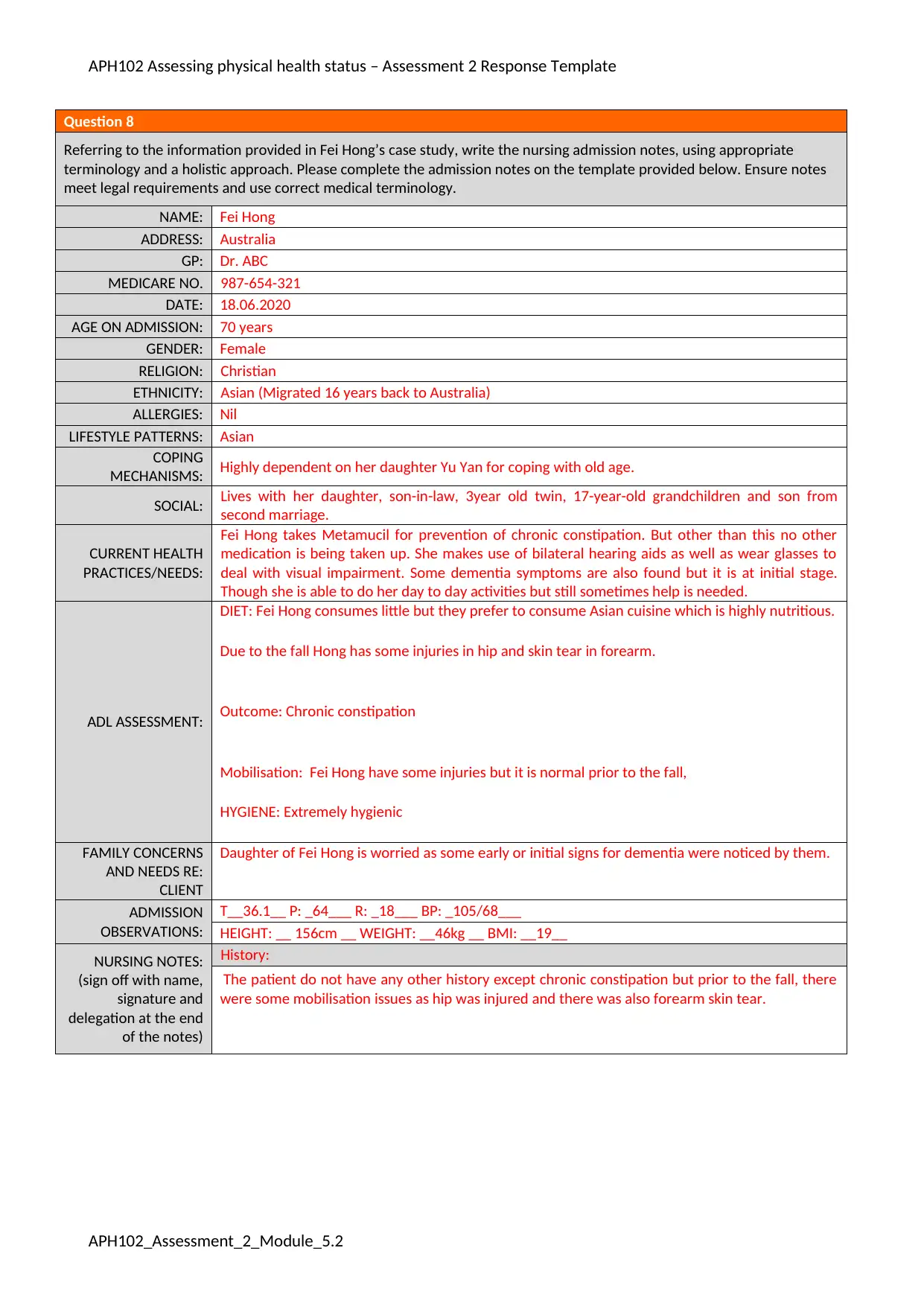
APH102 Assessing physical health status – Assessment 2 Response Template
Question 8
Referring to the information provided in Fei Hong’s case study, write the nursing admission notes, using appropriate
terminology and a holistic approach. Please complete the admission notes on the template provided below. Ensure notes
meet legal requirements and use correct medical terminology.
NAME: Fei Hong
ADDRESS: Australia
GP: Dr. ABC
MEDICARE NO. 987-654-321
DATE: 18.06.2020
AGE ON ADMISSION: 70 years
GENDER: Female
RELIGION: Christian
ETHNICITY: Asian (Migrated 16 years back to Australia)
ALLERGIES: Nil
LIFESTYLE PATTERNS: Asian
COPING
MECHANISMS: Highly dependent on her daughter Yu Yan for coping with old age.
SOCIAL: Lives with her daughter, son-in-law, 3year old twin, 17-year-old grandchildren and son from
second marriage.
CURRENT HEALTH
PRACTICES/NEEDS:
Fei Hong takes Metamucil for prevention of chronic constipation. But other than this no other
medication is being taken up. She makes use of bilateral hearing aids as well as wear glasses to
deal with visual impairment. Some dementia symptoms are also found but it is at initial stage.
Though she is able to do her day to day activities but still sometimes help is needed.
ADL ASSESSMENT:
DIET: Fei Hong consumes little but they prefer to consume Asian cuisine which is highly nutritious.
Due to the fall Hong has some injuries in hip and skin tear in forearm.
Outcome: Chronic constipation
Mobilisation: Fei Hong have some injuries but it is normal prior to the fall,
HYGIENE: Extremely hygienic
FAMILY CONCERNS
AND NEEDS RE:
CLIENT
Daughter of Fei Hong is worried as some early or initial signs for dementia were noticed by them.
ADMISSION
OBSERVATIONS:
T__36.1__ P: _64___ R: _18___ BP: _105/68___
HEIGHT: __ 156cm __ WEIGHT: __46kg __ BMI: __19__
NURSING NOTES:
(sign off with name,
signature and
delegation at the end
of the notes)
History:
The patient do not have any other history except chronic constipation but prior to the fall, there
were some mobilisation issues as hip was injured and there was also forearm skin tear.
APH102_Assessment_2_Module_5.2
Question 8
Referring to the information provided in Fei Hong’s case study, write the nursing admission notes, using appropriate
terminology and a holistic approach. Please complete the admission notes on the template provided below. Ensure notes
meet legal requirements and use correct medical terminology.
NAME: Fei Hong
ADDRESS: Australia
GP: Dr. ABC
MEDICARE NO. 987-654-321
DATE: 18.06.2020
AGE ON ADMISSION: 70 years
GENDER: Female
RELIGION: Christian
ETHNICITY: Asian (Migrated 16 years back to Australia)
ALLERGIES: Nil
LIFESTYLE PATTERNS: Asian
COPING
MECHANISMS: Highly dependent on her daughter Yu Yan for coping with old age.
SOCIAL: Lives with her daughter, son-in-law, 3year old twin, 17-year-old grandchildren and son from
second marriage.
CURRENT HEALTH
PRACTICES/NEEDS:
Fei Hong takes Metamucil for prevention of chronic constipation. But other than this no other
medication is being taken up. She makes use of bilateral hearing aids as well as wear glasses to
deal with visual impairment. Some dementia symptoms are also found but it is at initial stage.
Though she is able to do her day to day activities but still sometimes help is needed.
ADL ASSESSMENT:
DIET: Fei Hong consumes little but they prefer to consume Asian cuisine which is highly nutritious.
Due to the fall Hong has some injuries in hip and skin tear in forearm.
Outcome: Chronic constipation
Mobilisation: Fei Hong have some injuries but it is normal prior to the fall,
HYGIENE: Extremely hygienic
FAMILY CONCERNS
AND NEEDS RE:
CLIENT
Daughter of Fei Hong is worried as some early or initial signs for dementia were noticed by them.
ADMISSION
OBSERVATIONS:
T__36.1__ P: _64___ R: _18___ BP: _105/68___
HEIGHT: __ 156cm __ WEIGHT: __46kg __ BMI: __19__
NURSING NOTES:
(sign off with name,
signature and
delegation at the end
of the notes)
History:
The patient do not have any other history except chronic constipation but prior to the fall, there
were some mobilisation issues as hip was injured and there was also forearm skin tear.
APH102_Assessment_2_Module_5.2

APH102 Assessing physical health status – Assessment 2 Response Template
Assessment:
After the fall it has been observed that there was no fracture, swelling in hip, skin tear in forearm
but due to the bony prominences upon pelvis as well as enhancing hips risks leads to creation of
pressure areas.
Admission Plan:
Fei Hong needs to be assisted by physiotherapist as well as pain relief treatment due to the
injuries created by fall. In addition to this, daughter is worried for initial signs for dementia for
which it is necessary that mental health assessment must be carried out. Though patient is able to
do activities independently but there are certain times when assistance is needed.
Name: __________ABC_________ Signature ____ABC___________
Question 9
Another Nurse has drafted a plan of care for Fei Hong. Respond to the questions below based on the scope of your work as
an enrolled nurse, using 20 words for each:
How would you confirm that this plan reflects the needs of Fei Hong and her family?
If this care plan seems to conflict with a plan you feel is necessary, who would you speak with and how would you
justify your assumption?
If Fei Hong’s situation deteriorated after admission, who would you communicate this to, and when should that
be done?
Nursing diagnosis Planning (Nursing intervention) Expected Outcome Pain to hip and shoulder due to
bruising and swelling following fall
Monitor pain levels with regular pain assessments,
may need to use Abbey pain scale, due to limited
English.
Minimise pain by administering regular analgesia as
prescribed.
Apply ice pack to reduce swelling as required.
Pain assessment
scales reflect
reduced pain levels
after interventions.
Reduced mobility following fall
Enable Fei Hong to mobilise safely
Follow physiotherapy recommendations.
Fei Hong able to
mobilise with a
frame and
supervision.
Potential pressure area formation;
related to limited ability to move.
Provide regular pressure area care and assist with 2-4
hourly repositioning.
Use air mattress to reduce pressure areas.
Skin integrity
remains intact.
Potential infection due to
laceration/skin tear to arm
Keep wound clean, change dressings as prescribed.
Review surgical site for redness, swelling discharge.
Monitor temperature 4th hourly
Report any concerns to RN.
Optimal wound
healing without
infection.
Potential decline in emotional
state, related to lack of support in
exercising his religious faith and
limited communication due to
speaking little English
Allow time/support for Fei Hong to exercise her faith
as a coping mechanism.
Use pictograms to assist with communication, and
daughter/ interpreter to interpret on admission and
throughout the hospital stay.
Optimal emotional
state and Fei Hong
able to maintain
basic
communication
strategies.
APH102_Assessment_2_Module_5.2
Assessment:
After the fall it has been observed that there was no fracture, swelling in hip, skin tear in forearm
but due to the bony prominences upon pelvis as well as enhancing hips risks leads to creation of
pressure areas.
Admission Plan:
Fei Hong needs to be assisted by physiotherapist as well as pain relief treatment due to the
injuries created by fall. In addition to this, daughter is worried for initial signs for dementia for
which it is necessary that mental health assessment must be carried out. Though patient is able to
do activities independently but there are certain times when assistance is needed.
Name: __________ABC_________ Signature ____ABC___________
Question 9
Another Nurse has drafted a plan of care for Fei Hong. Respond to the questions below based on the scope of your work as
an enrolled nurse, using 20 words for each:
How would you confirm that this plan reflects the needs of Fei Hong and her family?
If this care plan seems to conflict with a plan you feel is necessary, who would you speak with and how would you
justify your assumption?
If Fei Hong’s situation deteriorated after admission, who would you communicate this to, and when should that
be done?
Nursing diagnosis Planning (Nursing intervention) Expected Outcome Pain to hip and shoulder due to
bruising and swelling following fall
Monitor pain levels with regular pain assessments,
may need to use Abbey pain scale, due to limited
English.
Minimise pain by administering regular analgesia as
prescribed.
Apply ice pack to reduce swelling as required.
Pain assessment
scales reflect
reduced pain levels
after interventions.
Reduced mobility following fall
Enable Fei Hong to mobilise safely
Follow physiotherapy recommendations.
Fei Hong able to
mobilise with a
frame and
supervision.
Potential pressure area formation;
related to limited ability to move.
Provide regular pressure area care and assist with 2-4
hourly repositioning.
Use air mattress to reduce pressure areas.
Skin integrity
remains intact.
Potential infection due to
laceration/skin tear to arm
Keep wound clean, change dressings as prescribed.
Review surgical site for redness, swelling discharge.
Monitor temperature 4th hourly
Report any concerns to RN.
Optimal wound
healing without
infection.
Potential decline in emotional
state, related to lack of support in
exercising his religious faith and
limited communication due to
speaking little English
Allow time/support for Fei Hong to exercise her faith
as a coping mechanism.
Use pictograms to assist with communication, and
daughter/ interpreter to interpret on admission and
throughout the hospital stay.
Optimal emotional
state and Fei Hong
able to maintain
basic
communication
strategies.
APH102_Assessment_2_Module_5.2
Secure Best Marks with AI Grader
Need help grading? Try our AI Grader for instant feedback on your assignments.
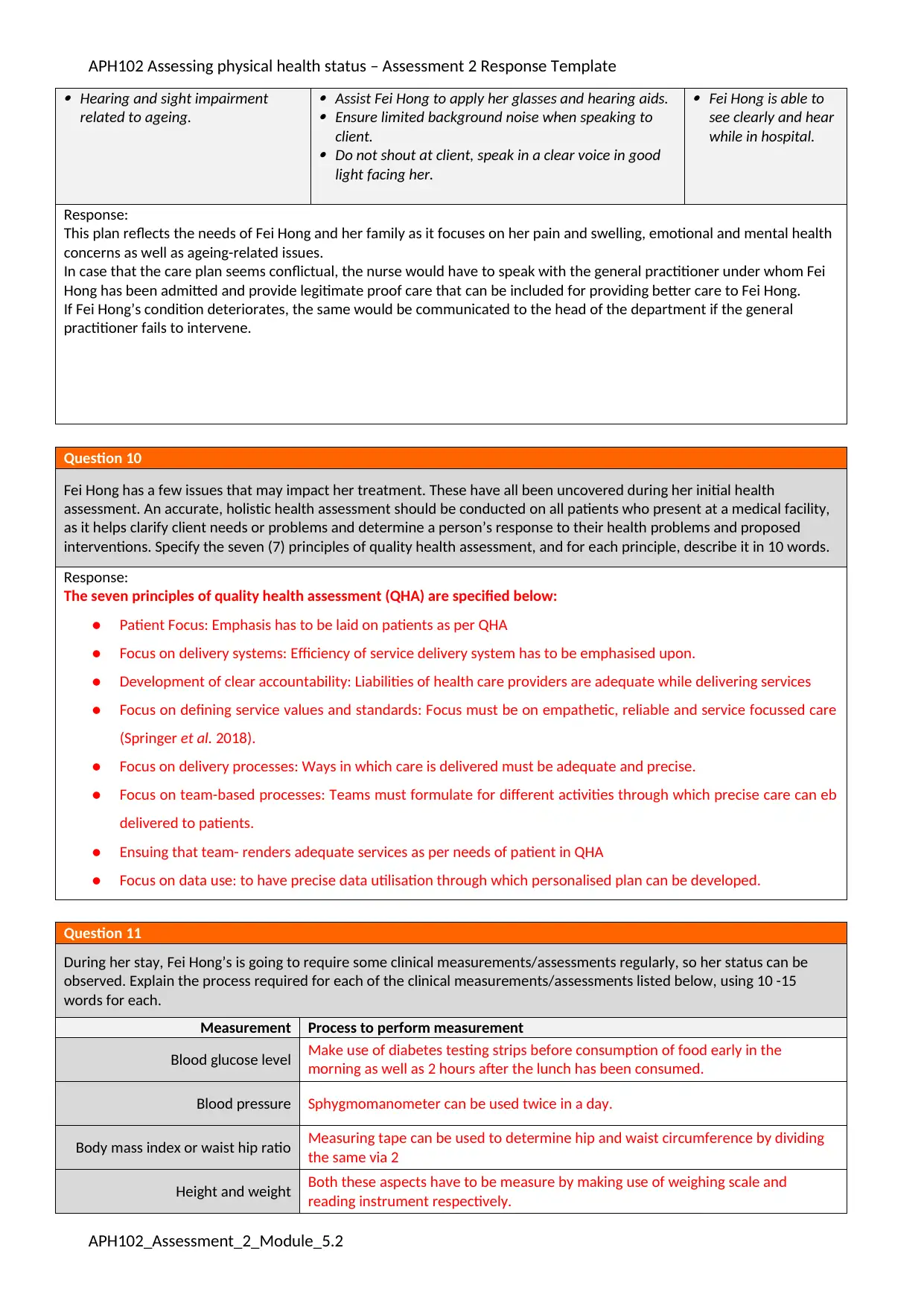
APH102 Assessing physical health status – Assessment 2 Response Template
Hearing and sight impairment
related to ageing.
Assist Fei Hong to apply her glasses and hearing aids.
Ensure limited background noise when speaking to
client.
Do not shout at client, speak in a clear voice in good
light facing her.
Fei Hong is able to
see clearly and hear
while in hospital.
Response:
This plan reflects the needs of Fei Hong and her family as it focuses on her pain and swelling, emotional and mental health
concerns as well as ageing-related issues.
In case that the care plan seems conflictual, the nurse would have to speak with the general practitioner under whom Fei
Hong has been admitted and provide legitimate proof care that can be included for providing better care to Fei Hong.
If Fei Hong’s condition deteriorates, the same would be communicated to the head of the department if the general
practitioner fails to intervene.
Question 10
Fei Hong has a few issues that may impact her treatment. These have all been uncovered during her initial health
assessment. An accurate, holistic health assessment should be conducted on all patients who present at a medical facility,
as it helps clarify client needs or problems and determine a person’s response to their health problems and proposed
interventions. Specify the seven (7) principles of quality health assessment, and for each principle, describe it in 10 words.
Response:
The seven principles of quality health assessment (QHA) are specified below:
● Patient Focus: Emphasis has to be laid on patients as per QHA
● Focus on delivery systems: Efficiency of service delivery system has to be emphasised upon.
● Development of clear accountability: Liabilities of health care providers are adequate while delivering services
● Focus on defining service values and standards: Focus must be on empathetic, reliable and service focussed care
(Springer et al. 2018).
● Focus on delivery processes: Ways in which care is delivered must be adequate and precise.
● Focus on team-based processes: Teams must formulate for different activities through which precise care can eb
delivered to patients.
● Ensuing that team- renders adequate services as per needs of patient in QHA
● Focus on data use: to have precise data utilisation through which personalised plan can be developed.
Question 11
During her stay, Fei Hong’s is going to require some clinical measurements/assessments regularly, so her status can be
observed. Explain the process required for each of the clinical measurements/assessments listed below, using 10 -15
words for each.
Measurement Process to perform measurement
Blood glucose level Make use of diabetes testing strips before consumption of food early in the
morning as well as 2 hours after the lunch has been consumed.
Blood pressure Sphygmomanometer can be used twice in a day.
Body mass index or waist hip ratio Measuring tape can be used to determine hip and waist circumference by dividing
the same via 2
Height and weight Both these aspects have to be measure by making use of weighing scale and
reading instrument respectively.
APH102_Assessment_2_Module_5.2
Hearing and sight impairment
related to ageing.
Assist Fei Hong to apply her glasses and hearing aids.
Ensure limited background noise when speaking to
client.
Do not shout at client, speak in a clear voice in good
light facing her.
Fei Hong is able to
see clearly and hear
while in hospital.
Response:
This plan reflects the needs of Fei Hong and her family as it focuses on her pain and swelling, emotional and mental health
concerns as well as ageing-related issues.
In case that the care plan seems conflictual, the nurse would have to speak with the general practitioner under whom Fei
Hong has been admitted and provide legitimate proof care that can be included for providing better care to Fei Hong.
If Fei Hong’s condition deteriorates, the same would be communicated to the head of the department if the general
practitioner fails to intervene.
Question 10
Fei Hong has a few issues that may impact her treatment. These have all been uncovered during her initial health
assessment. An accurate, holistic health assessment should be conducted on all patients who present at a medical facility,
as it helps clarify client needs or problems and determine a person’s response to their health problems and proposed
interventions. Specify the seven (7) principles of quality health assessment, and for each principle, describe it in 10 words.
Response:
The seven principles of quality health assessment (QHA) are specified below:
● Patient Focus: Emphasis has to be laid on patients as per QHA
● Focus on delivery systems: Efficiency of service delivery system has to be emphasised upon.
● Development of clear accountability: Liabilities of health care providers are adequate while delivering services
● Focus on defining service values and standards: Focus must be on empathetic, reliable and service focussed care
(Springer et al. 2018).
● Focus on delivery processes: Ways in which care is delivered must be adequate and precise.
● Focus on team-based processes: Teams must formulate for different activities through which precise care can eb
delivered to patients.
● Ensuing that team- renders adequate services as per needs of patient in QHA
● Focus on data use: to have precise data utilisation through which personalised plan can be developed.
Question 11
During her stay, Fei Hong’s is going to require some clinical measurements/assessments regularly, so her status can be
observed. Explain the process required for each of the clinical measurements/assessments listed below, using 10 -15
words for each.
Measurement Process to perform measurement
Blood glucose level Make use of diabetes testing strips before consumption of food early in the
morning as well as 2 hours after the lunch has been consumed.
Blood pressure Sphygmomanometer can be used twice in a day.
Body mass index or waist hip ratio Measuring tape can be used to determine hip and waist circumference by dividing
the same via 2
Height and weight Both these aspects have to be measure by making use of weighing scale and
reading instrument respectively.
APH102_Assessment_2_Module_5.2
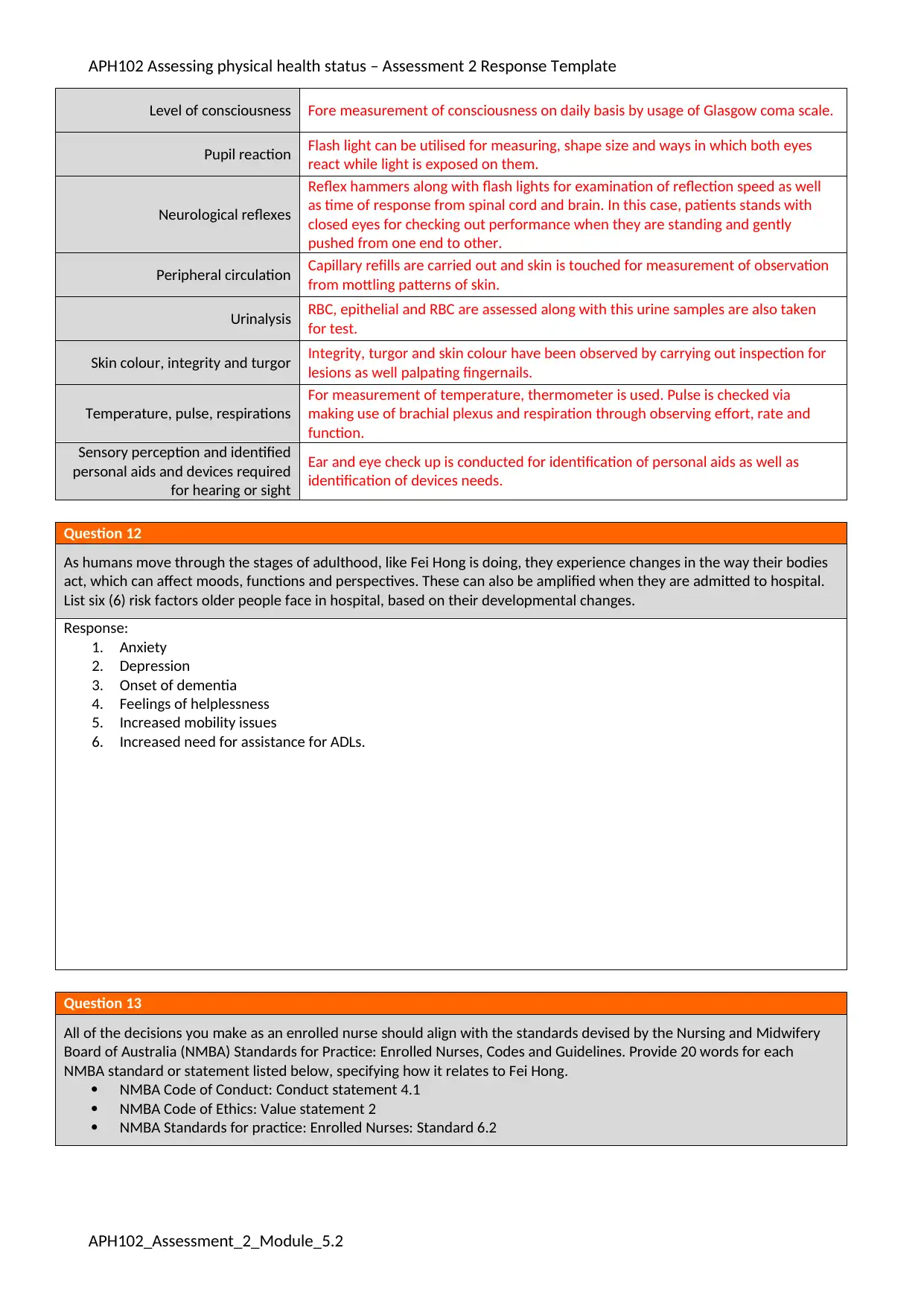
APH102 Assessing physical health status – Assessment 2 Response Template
Level of consciousness Fore measurement of consciousness on daily basis by usage of Glasgow coma scale.
Pupil reaction Flash light can be utilised for measuring, shape size and ways in which both eyes
react while light is exposed on them.
Neurological reflexes
Reflex hammers along with flash lights for examination of reflection speed as well
as time of response from spinal cord and brain. In this case, patients stands with
closed eyes for checking out performance when they are standing and gently
pushed from one end to other.
Peripheral circulation Capillary refills are carried out and skin is touched for measurement of observation
from mottling patterns of skin.
Urinalysis RBC, epithelial and RBC are assessed along with this urine samples are also taken
for test.
Skin colour, integrity and turgor Integrity, turgor and skin colour have been observed by carrying out inspection for
lesions as well palpating fingernails.
Temperature, pulse, respirations
For measurement of temperature, thermometer is used. Pulse is checked via
making use of brachial plexus and respiration through observing effort, rate and
function.
Sensory perception and identified
personal aids and devices required
for hearing or sight
Ear and eye check up is conducted for identification of personal aids as well as
identification of devices needs.
Question 12
As humans move through the stages of adulthood, like Fei Hong is doing, they experience changes in the way their bodies
act, which can affect moods, functions and perspectives. These can also be amplified when they are admitted to hospital.
List six (6) risk factors older people face in hospital, based on their developmental changes.
Response:
1. Anxiety
2. Depression
3. Onset of dementia
4. Feelings of helplessness
5. Increased mobility issues
6. Increased need for assistance for ADLs.
Question 13
All of the decisions you make as an enrolled nurse should align with the standards devised by the Nursing and Midwifery
Board of Australia (NMBA) Standards for Practice: Enrolled Nurses, Codes and Guidelines. Provide 20 words for each
NMBA standard or statement listed below, specifying how it relates to Fei Hong.
NMBA Code of Conduct: Conduct statement 4.1
NMBA Code of Ethics: Value statement 2
NMBA Standards for practice: Enrolled Nurses: Standard 6.2
APH102_Assessment_2_Module_5.2
Level of consciousness Fore measurement of consciousness on daily basis by usage of Glasgow coma scale.
Pupil reaction Flash light can be utilised for measuring, shape size and ways in which both eyes
react while light is exposed on them.
Neurological reflexes
Reflex hammers along with flash lights for examination of reflection speed as well
as time of response from spinal cord and brain. In this case, patients stands with
closed eyes for checking out performance when they are standing and gently
pushed from one end to other.
Peripheral circulation Capillary refills are carried out and skin is touched for measurement of observation
from mottling patterns of skin.
Urinalysis RBC, epithelial and RBC are assessed along with this urine samples are also taken
for test.
Skin colour, integrity and turgor Integrity, turgor and skin colour have been observed by carrying out inspection for
lesions as well palpating fingernails.
Temperature, pulse, respirations
For measurement of temperature, thermometer is used. Pulse is checked via
making use of brachial plexus and respiration through observing effort, rate and
function.
Sensory perception and identified
personal aids and devices required
for hearing or sight
Ear and eye check up is conducted for identification of personal aids as well as
identification of devices needs.
Question 12
As humans move through the stages of adulthood, like Fei Hong is doing, they experience changes in the way their bodies
act, which can affect moods, functions and perspectives. These can also be amplified when they are admitted to hospital.
List six (6) risk factors older people face in hospital, based on their developmental changes.
Response:
1. Anxiety
2. Depression
3. Onset of dementia
4. Feelings of helplessness
5. Increased mobility issues
6. Increased need for assistance for ADLs.
Question 13
All of the decisions you make as an enrolled nurse should align with the standards devised by the Nursing and Midwifery
Board of Australia (NMBA) Standards for Practice: Enrolled Nurses, Codes and Guidelines. Provide 20 words for each
NMBA standard or statement listed below, specifying how it relates to Fei Hong.
NMBA Code of Conduct: Conduct statement 4.1
NMBA Code of Ethics: Value statement 2
NMBA Standards for practice: Enrolled Nurses: Standard 6.2
APH102_Assessment_2_Module_5.2

APH102 Assessing physical health status – Assessment 2 Response Template
Response:
NMBA Code of Conduct: Conduct statement 4.1- Maintenance of professional boundaries would be essential while
providing care to Fei Hong. This would ensure that the nurse does not get too attached with her
((Nursingmidwiferyboard.gov.au, 2020).
NMBA Code of Ethics: Value statement 2- Following the value statement would help nurses to provide high-quality care to
Fei Hong.
NMBA Standards for practice: Enrolled Nurses: Standard 6.2- Fei Hong would be provided with skilled and timely care
that focuses on encouraging her involvement in the decision making process (Nursingmidwiferyboard.gov.au, 2020).
Question 14
Yu Yan and Fei Hong have a complex family. It is made up of different members, with a range of differing needs. In 50
words, explain the objective of understanding ‘family health care needs’ and describe two (2) techniques nurses can use to
increase a family’s involvement in their child’s care during hospitalisation.
Response:
The key objective behind understanding “family health care needs” is to provide a holistic care approach which needs the
physical and mental health care needs of all family members. The two techniques which can be used by nurses for
increasing family’s involvement in their child care’s during hospitalisation are defining their role in providing care and their
role in the decision making process of care planning for the child.
Question 15
Disease and illness can be caused by a number of factors, no matter the age of a person. These factors can also impact
people in different ways. For each cause listed below, specify at least one (1) key feature, physical, emotional and mental
impact that might occur because of them.
Cause Key Feature Physical Impact Emotional Impact Mental Impact
Pathogens
Some pathogens have
the ability to change
forms depending on
circumstances.
Leads to infections
and fever symptoms
Can lead to
depression-like
emotional state
Can lead to mental
health disorders
Inherited genetic
conditions
Can be passed down
from generation to
generation
Can lead to physical
illnesses such as high
blood pressure
Can lead to emotional
instability
Can lead to migraines,
anxiety and
depression
APH102_Assessment_2_Module_5.2
Response:
NMBA Code of Conduct: Conduct statement 4.1- Maintenance of professional boundaries would be essential while
providing care to Fei Hong. This would ensure that the nurse does not get too attached with her
((Nursingmidwiferyboard.gov.au, 2020).
NMBA Code of Ethics: Value statement 2- Following the value statement would help nurses to provide high-quality care to
Fei Hong.
NMBA Standards for practice: Enrolled Nurses: Standard 6.2- Fei Hong would be provided with skilled and timely care
that focuses on encouraging her involvement in the decision making process (Nursingmidwiferyboard.gov.au, 2020).
Question 14
Yu Yan and Fei Hong have a complex family. It is made up of different members, with a range of differing needs. In 50
words, explain the objective of understanding ‘family health care needs’ and describe two (2) techniques nurses can use to
increase a family’s involvement in their child’s care during hospitalisation.
Response:
The key objective behind understanding “family health care needs” is to provide a holistic care approach which needs the
physical and mental health care needs of all family members. The two techniques which can be used by nurses for
increasing family’s involvement in their child care’s during hospitalisation are defining their role in providing care and their
role in the decision making process of care planning for the child.
Question 15
Disease and illness can be caused by a number of factors, no matter the age of a person. These factors can also impact
people in different ways. For each cause listed below, specify at least one (1) key feature, physical, emotional and mental
impact that might occur because of them.
Cause Key Feature Physical Impact Emotional Impact Mental Impact
Pathogens
Some pathogens have
the ability to change
forms depending on
circumstances.
Leads to infections
and fever symptoms
Can lead to
depression-like
emotional state
Can lead to mental
health disorders
Inherited genetic
conditions
Can be passed down
from generation to
generation
Can lead to physical
illnesses such as high
blood pressure
Can lead to emotional
instability
Can lead to migraines,
anxiety and
depression
APH102_Assessment_2_Module_5.2
Paraphrase This Document
Need a fresh take? Get an instant paraphrase of this document with our AI Paraphraser
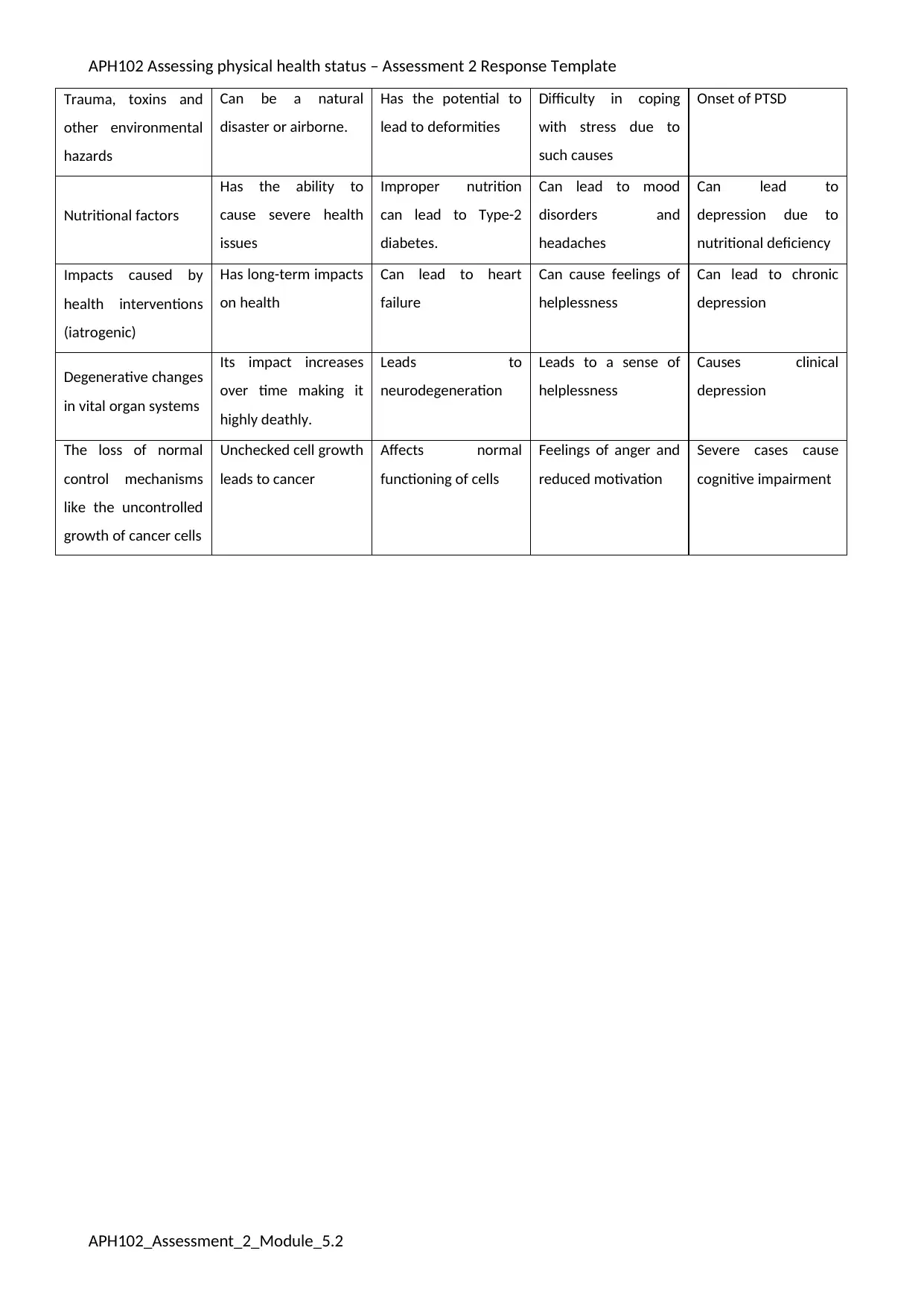
APH102 Assessing physical health status – Assessment 2 Response Template
Trauma, toxins and
other environmental
hazards
Can be a natural
disaster or airborne.
Has the potential to
lead to deformities
Difficulty in coping
with stress due to
such causes
Onset of PTSD
Nutritional factors
Has the ability to
cause severe health
issues
Improper nutrition
can lead to Type-2
diabetes.
Can lead to mood
disorders and
headaches
Can lead to
depression due to
nutritional deficiency
Impacts caused by
health interventions
(iatrogenic)
Has long-term impacts
on health
Can lead to heart
failure
Can cause feelings of
helplessness
Can lead to chronic
depression
Degenerative changes
in vital organ systems
Its impact increases
over time making it
highly deathly.
Leads to
neurodegeneration
Leads to a sense of
helplessness
Causes clinical
depression
The loss of normal
control mechanisms
like the uncontrolled
growth of cancer cells
Unchecked cell growth
leads to cancer
Affects normal
functioning of cells
Feelings of anger and
reduced motivation
Severe cases cause
cognitive impairment
APH102_Assessment_2_Module_5.2
Trauma, toxins and
other environmental
hazards
Can be a natural
disaster or airborne.
Has the potential to
lead to deformities
Difficulty in coping
with stress due to
such causes
Onset of PTSD
Nutritional factors
Has the ability to
cause severe health
issues
Improper nutrition
can lead to Type-2
diabetes.
Can lead to mood
disorders and
headaches
Can lead to
depression due to
nutritional deficiency
Impacts caused by
health interventions
(iatrogenic)
Has long-term impacts
on health
Can lead to heart
failure
Can cause feelings of
helplessness
Can lead to chronic
depression
Degenerative changes
in vital organ systems
Its impact increases
over time making it
highly deathly.
Leads to
neurodegeneration
Leads to a sense of
helplessness
Causes clinical
depression
The loss of normal
control mechanisms
like the uncontrolled
growth of cancer cells
Unchecked cell growth
leads to cancer
Affects normal
functioning of cells
Feelings of anger and
reduced motivation
Severe cases cause
cognitive impairment
APH102_Assessment_2_Module_5.2
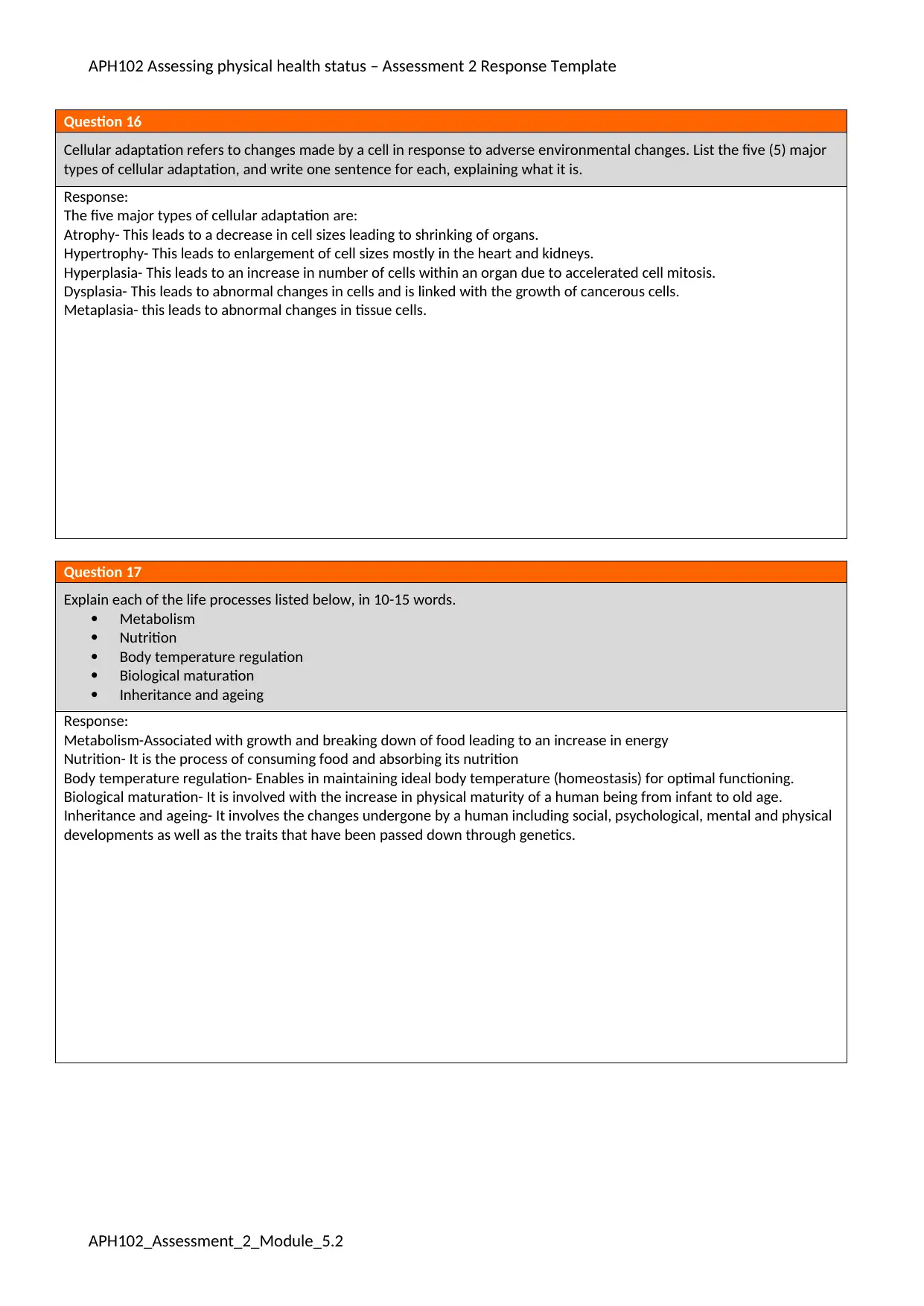
APH102 Assessing physical health status – Assessment 2 Response Template
Question 16
Cellular adaptation refers to changes made by a cell in response to adverse environmental changes. List the five (5) major
types of cellular adaptation, and write one sentence for each, explaining what it is.
Response:
The five major types of cellular adaptation are:
Atrophy- This leads to a decrease in cell sizes leading to shrinking of organs.
Hypertrophy- This leads to enlargement of cell sizes mostly in the heart and kidneys.
Hyperplasia- This leads to an increase in number of cells within an organ due to accelerated cell mitosis.
Dysplasia- This leads to abnormal changes in cells and is linked with the growth of cancerous cells.
Metaplasia- this leads to abnormal changes in tissue cells.
Question 17
Explain each of the life processes listed below, in 10-15 words.
Metabolism
Nutrition
Body temperature regulation
Biological maturation
Inheritance and ageing
Response:
Metabolism-Associated with growth and breaking down of food leading to an increase in energy
Nutrition- It is the process of consuming food and absorbing its nutrition
Body temperature regulation- Enables in maintaining ideal body temperature (homeostasis) for optimal functioning.
Biological maturation- It is involved with the increase in physical maturity of a human being from infant to old age.
Inheritance and ageing- It involves the changes undergone by a human including social, psychological, mental and physical
developments as well as the traits that have been passed down through genetics.
APH102_Assessment_2_Module_5.2
Question 16
Cellular adaptation refers to changes made by a cell in response to adverse environmental changes. List the five (5) major
types of cellular adaptation, and write one sentence for each, explaining what it is.
Response:
The five major types of cellular adaptation are:
Atrophy- This leads to a decrease in cell sizes leading to shrinking of organs.
Hypertrophy- This leads to enlargement of cell sizes mostly in the heart and kidneys.
Hyperplasia- This leads to an increase in number of cells within an organ due to accelerated cell mitosis.
Dysplasia- This leads to abnormal changes in cells and is linked with the growth of cancerous cells.
Metaplasia- this leads to abnormal changes in tissue cells.
Question 17
Explain each of the life processes listed below, in 10-15 words.
Metabolism
Nutrition
Body temperature regulation
Biological maturation
Inheritance and ageing
Response:
Metabolism-Associated with growth and breaking down of food leading to an increase in energy
Nutrition- It is the process of consuming food and absorbing its nutrition
Body temperature regulation- Enables in maintaining ideal body temperature (homeostasis) for optimal functioning.
Biological maturation- It is involved with the increase in physical maturity of a human being from infant to old age.
Inheritance and ageing- It involves the changes undergone by a human including social, psychological, mental and physical
developments as well as the traits that have been passed down through genetics.
APH102_Assessment_2_Module_5.2
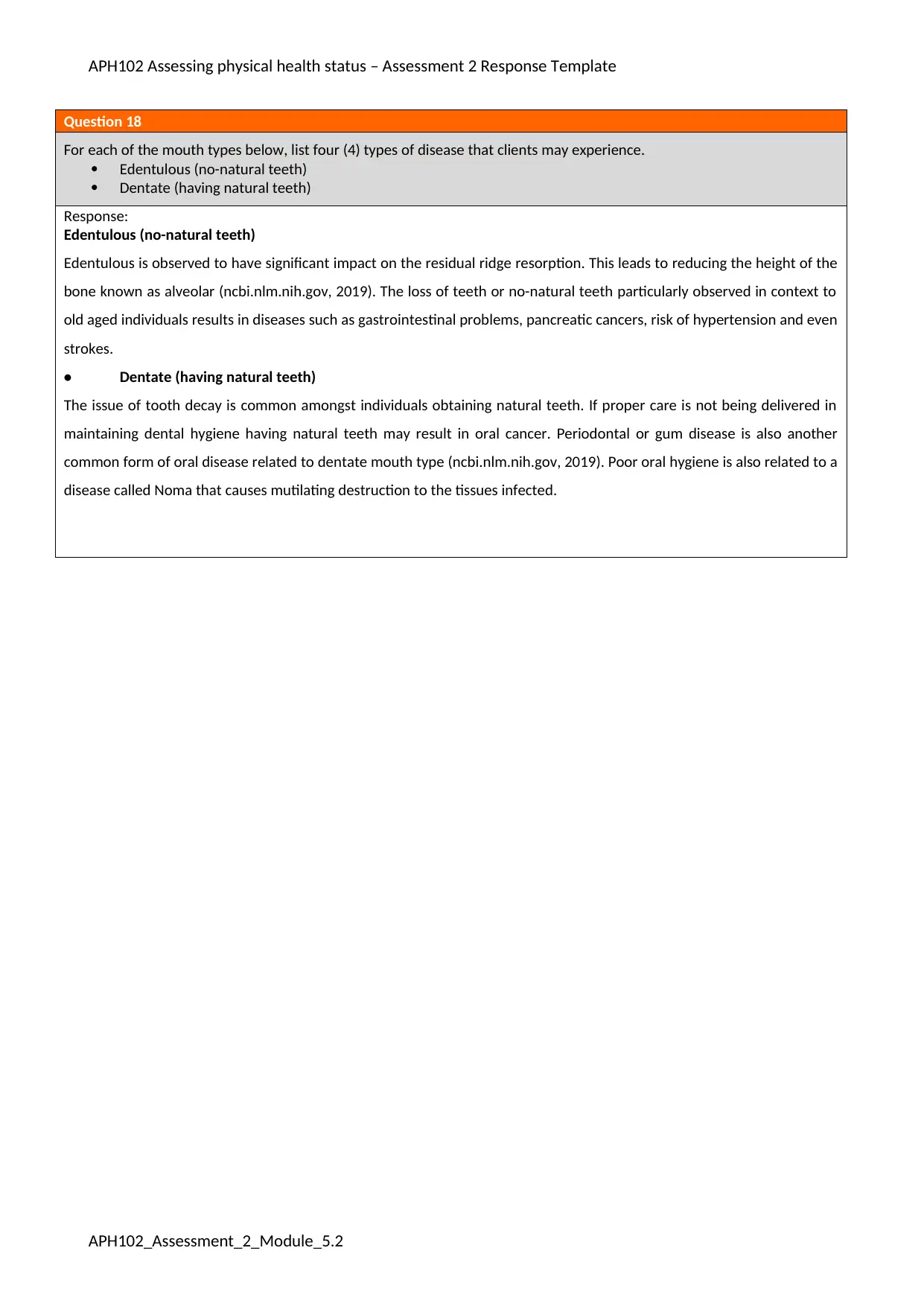
APH102 Assessing physical health status – Assessment 2 Response Template
Question 18
For each of the mouth types below, list four (4) types of disease that clients may experience.
Edentulous (no-natural teeth)
Dentate (having natural teeth)
Response:
Edentulous (no-natural teeth)
Edentulous is observed to have significant impact on the residual ridge resorption. This leads to reducing the height of the
bone known as alveolar (ncbi.nlm.nih.gov, 2019). The loss of teeth or no-natural teeth particularly observed in context to
old aged individuals results in diseases such as gastrointestinal problems, pancreatic cancers, risk of hypertension and even
strokes.
• Dentate (having natural teeth)
The issue of tooth decay is common amongst individuals obtaining natural teeth. If proper care is not being delivered in
maintaining dental hygiene having natural teeth may result in oral cancer. Periodontal or gum disease is also another
common form of oral disease related to dentate mouth type (ncbi.nlm.nih.gov, 2019). Poor oral hygiene is also related to a
disease called Noma that causes mutilating destruction to the tissues infected.
APH102_Assessment_2_Module_5.2
Question 18
For each of the mouth types below, list four (4) types of disease that clients may experience.
Edentulous (no-natural teeth)
Dentate (having natural teeth)
Response:
Edentulous (no-natural teeth)
Edentulous is observed to have significant impact on the residual ridge resorption. This leads to reducing the height of the
bone known as alveolar (ncbi.nlm.nih.gov, 2019). The loss of teeth or no-natural teeth particularly observed in context to
old aged individuals results in diseases such as gastrointestinal problems, pancreatic cancers, risk of hypertension and even
strokes.
• Dentate (having natural teeth)
The issue of tooth decay is common amongst individuals obtaining natural teeth. If proper care is not being delivered in
maintaining dental hygiene having natural teeth may result in oral cancer. Periodontal or gum disease is also another
common form of oral disease related to dentate mouth type (ncbi.nlm.nih.gov, 2019). Poor oral hygiene is also related to a
disease called Noma that causes mutilating destruction to the tissues infected.
APH102_Assessment_2_Module_5.2
Secure Best Marks with AI Grader
Need help grading? Try our AI Grader for instant feedback on your assignments.
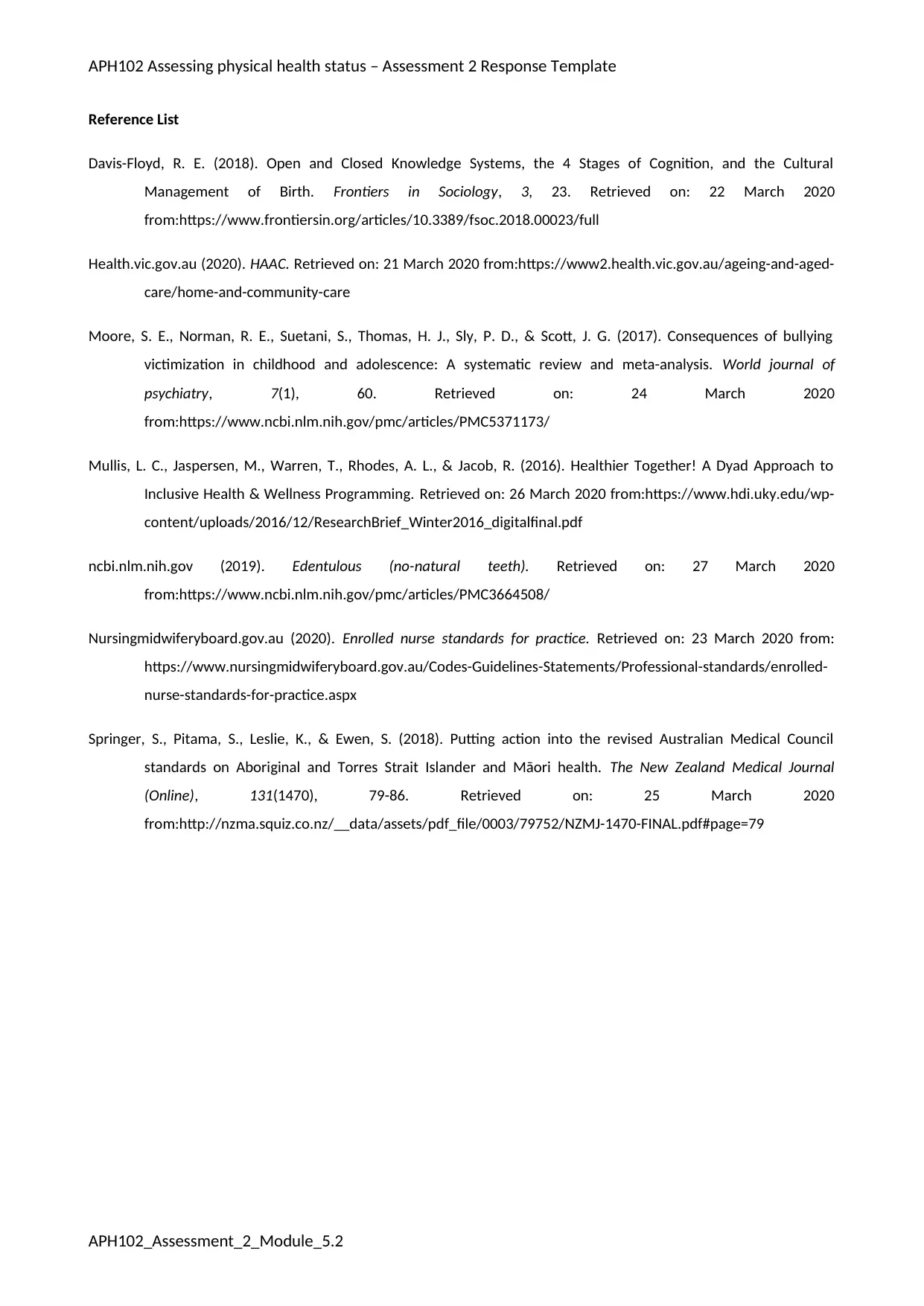
APH102 Assessing physical health status – Assessment 2 Response Template
Reference List
Davis-Floyd, R. E. (2018). Open and Closed Knowledge Systems, the 4 Stages of Cognition, and the Cultural
Management of Birth. Frontiers in Sociology, 3, 23. Retrieved on: 22 March 2020
from:https://www.frontiersin.org/articles/10.3389/fsoc.2018.00023/full
Health.vic.gov.au (2020). HAAC. Retrieved on: 21 March 2020 from:https://www2.health.vic.gov.au/ageing-and-aged-
care/home-and-community-care
Moore, S. E., Norman, R. E., Suetani, S., Thomas, H. J., Sly, P. D., & Scott, J. G. (2017). Consequences of bullying
victimization in childhood and adolescence: A systematic review and meta-analysis. World journal of
psychiatry, 7(1), 60. Retrieved on: 24 March 2020
from:https://www.ncbi.nlm.nih.gov/pmc/articles/PMC5371173/
Mullis, L. C., Jaspersen, M., Warren, T., Rhodes, A. L., & Jacob, R. (2016). Healthier Together! A Dyad Approach to
Inclusive Health & Wellness Programming. Retrieved on: 26 March 2020 from:https://www.hdi.uky.edu/wp-
content/uploads/2016/12/ResearchBrief_Winter2016_digitalfinal.pdf
ncbi.nlm.nih.gov (2019). Edentulous (no-natural teeth). Retrieved on: 27 March 2020
from:https://www.ncbi.nlm.nih.gov/pmc/articles/PMC3664508/
Nursingmidwiferyboard.gov.au (2020). Enrolled nurse standards for practice. Retrieved on: 23 March 2020 from:
https://www.nursingmidwiferyboard.gov.au/Codes-Guidelines-Statements/Professional-standards/enrolled-
nurse-standards-for-practice.aspx
Springer, S., Pitama, S., Leslie, K., & Ewen, S. (2018). Putting action into the revised Australian Medical Council
standards on Aboriginal and Torres Strait Islander and Māori health. The New Zealand Medical Journal
(Online), 131(1470), 79-86. Retrieved on: 25 March 2020
from:http://nzma.squiz.co.nz/__data/assets/pdf_file/0003/79752/NZMJ-1470-FINAL.pdf#page=79
APH102_Assessment_2_Module_5.2
Reference List
Davis-Floyd, R. E. (2018). Open and Closed Knowledge Systems, the 4 Stages of Cognition, and the Cultural
Management of Birth. Frontiers in Sociology, 3, 23. Retrieved on: 22 March 2020
from:https://www.frontiersin.org/articles/10.3389/fsoc.2018.00023/full
Health.vic.gov.au (2020). HAAC. Retrieved on: 21 March 2020 from:https://www2.health.vic.gov.au/ageing-and-aged-
care/home-and-community-care
Moore, S. E., Norman, R. E., Suetani, S., Thomas, H. J., Sly, P. D., & Scott, J. G. (2017). Consequences of bullying
victimization in childhood and adolescence: A systematic review and meta-analysis. World journal of
psychiatry, 7(1), 60. Retrieved on: 24 March 2020
from:https://www.ncbi.nlm.nih.gov/pmc/articles/PMC5371173/
Mullis, L. C., Jaspersen, M., Warren, T., Rhodes, A. L., & Jacob, R. (2016). Healthier Together! A Dyad Approach to
Inclusive Health & Wellness Programming. Retrieved on: 26 March 2020 from:https://www.hdi.uky.edu/wp-
content/uploads/2016/12/ResearchBrief_Winter2016_digitalfinal.pdf
ncbi.nlm.nih.gov (2019). Edentulous (no-natural teeth). Retrieved on: 27 March 2020
from:https://www.ncbi.nlm.nih.gov/pmc/articles/PMC3664508/
Nursingmidwiferyboard.gov.au (2020). Enrolled nurse standards for practice. Retrieved on: 23 March 2020 from:
https://www.nursingmidwiferyboard.gov.au/Codes-Guidelines-Statements/Professional-standards/enrolled-
nurse-standards-for-practice.aspx
Springer, S., Pitama, S., Leslie, K., & Ewen, S. (2018). Putting action into the revised Australian Medical Council
standards on Aboriginal and Torres Strait Islander and Māori health. The New Zealand Medical Journal
(Online), 131(1470), 79-86. Retrieved on: 25 March 2020
from:http://nzma.squiz.co.nz/__data/assets/pdf_file/0003/79752/NZMJ-1470-FINAL.pdf#page=79
APH102_Assessment_2_Module_5.2
1 out of 17
Related Documents
Your All-in-One AI-Powered Toolkit for Academic Success.
+13062052269
info@desklib.com
Available 24*7 on WhatsApp / Email
![[object Object]](/_next/static/media/star-bottom.7253800d.svg)
Unlock your academic potential
© 2024 | Zucol Services PVT LTD | All rights reserved.





